Flying While Pregnant? Check Out the Policies on 25 Global Airlines
In the absence of obstetric or medical complications, occasional air travel during pregnancy is generally safe, according to the American College of Obstetrics and Gynecology (ACOG). Like other travelers, pregnant women should use seat belts while seated.
Most commercial airlines allow pregnant women to fly up to 36 weeks of gestation, with some restrictions on international flights.
ACOG does not recommend air travel for pregnant women with medical or obstetric conditions that may be exacerbated by flight or that could require emergency care. It advises checking flight durations when planning travel and that the most common obstetric emergencies occur in the first and third trimesters.
Once aboard a flight, conditions including changes in cabin pressure and low humidity, coupled with the physiologic changes of pregnancy, do result in adaptations, including increased heart rate and blood pressure, reports ACOG. And those traveling on long-haul flights face the risks associated with immobilization and low cabin humidity. This can cause issues such as lower extremity edema and venous thrombotic events.
ACOG recommends preventive measures to minimize these risks, including the use of support stockings, regular movement of the lower extremities, avoid wearing restrictive clothing and encourage regular hydration. It also advises against consuming gas-producing foods or drinks before a flight.
Other ways for pregnant women to be comfortable on their flights include: booking a bulkhead seat for more legroom; reserving an aisle seat for easy access to lavatories and to walk; elevating your legs on a carry-on bag to avoid swelling and cramps; and wearing a layered, comfortable outfit for changing cabin temperatures.
Airlines around the world have different rules and regulations on when and how long pregnant women can fly. Below are the policies from 25 airlines around the world.
The French flag carrier does not require pregnant women to carry a medical certificate for travel during pregnancy. It recommends avoiding travel in the final month of pregnancy, as well as during the first seven days after delivery. The airline also recommends expecting mothers seek their doctor's opinion before traveling.
India’s flag carrier allows expectant mothers in good health to fly up to and including their 27th week of pregnancy. After 27 weeks, if the pregnancy is anticipated to be a normal delivery, an expectant mother will be accepted for travel up to the 35th week, but a medical certificate confirming the mother is fit to travel is required by an attending obstetrician and dated within three days of travel.

Air New Zealand
For single, uncomplicated pregnancies and clearance from a doctor or midwife women can take flights more than four hours up to the end of their 36th week. For flights under four hours, it's up to the end of the 40th week. Women pregnant with twins can fly more than four hours up to their 32nd week and less than four hours until the 36th week.
The airline recommends that women past their 28th week carry a letter from a doctor or midwife that says you are fit for travel, confirming your pregnancy dates and that there are no complications.
The airline's medical team must offer clearance for women experiencing the following: a complicated pregnancy, such as placenta previa or bleeding; a multiple pregnancy; a history of premature labor; or have begun the early stages of labor.
Italy's flag carrier has no travel restrictions for expectant mothers during the first eight months of pregnancy. But if traveling within the last four weeks of pregnancy, expecting multiple births, or having a complicated pregnancy, medical clearance is required. Completion of a Medical Information Form, MEDIF , prior to travel and signed by both the passenger and doctor is required.
Alitalia advises pregnant not to fly seven days prior to and seven days after giving birth, or if there is a risk of a premature birth or other complications. It will make staff available to escort pregnant women from the airport check-in counter to the boarding gate. Staff onboard the flight will help stow carry-on luggage. Seats can be pre-assigned and women cannot sit in an exit row.
All Nippon Airways
The Japanese carrier requires women within 15 to 28 days of their due date to fill out and carry a medical information form . Women within 14 days of their due date are required to have a medical form and travel with a doctor. The form must indicate there are no complications of pregnancy, that the passenger has no health problems preventing them from flying and the due date. It must be completed by a doctor and submitted no more than seven days prior to departure.
American Airlines
The Fort Worth-based carrier has different rules for international and domestic flights. If a due date is within four weeks of a flight, you must provide a doctor’s certificate stating that you’ve been recently examined and you’re fit to fly. For domestic flights under five hours, pregnant women won’t be permitted to travel within seven days (before and after) their delivery date. Those who need travel within this timeframe will need approval from a physician and help from a special assistance coordinator . The pregnant woman's physician will be required to fill out a passenger medical form before a flight. A special assistance coordinator will send the form directly to your physician.
Clearance from a special assistance coordinator is required for international travel or travel over water. Within four weeks of a due date also requires a physician's note stating that you’ve been examined within the past 48 hours and you’re fit to fly. And seven days before or after delivery also requires a passenger medical form to be completed by your physician.
British Airways
The U.K. carrier does not allow pregnant women to fly after the end of the 36th week if you are pregnant with one baby or the end of the 32nd week if you are pregnant with more than one baby. While it isn't mandated, British Airways recommends all expecting mothers carry a confirmation from a doctor or midwife, such as a letter or certificate, in addition to your pregnancy record. It should be written within seven days prior to travel and confirm your approximate due date, that you're fit to travel and that there are no complications with your pregnancy.
Cathay Pacific
Hong Kong's flag carrier requires that women with pregnancies after 28 weeks carry a medical certificate, dated within 10 days of travel that states the following:
- single or multiple pregnancy
- estimated week of pregnancy
- expected due date
- certifying you are in good health and the pregnancy is progressing normally, without complications
- that you are fit to travel
The airline accepts pregnant women with uncomplicated single pregnancies to travel up to 36 weeks and uncomplicated multiple pregnancies up to 32 weeks.
Delta Air Lines
The Atlanta-based carrier does not impose restrictions on flying for pregnant women, so a medical certificate is not required to travel. But the airline will not waive ticket change fees and penalties for pregnancy. The airline recommends that those flying after their eight month should check with their doctor to be sure travel is not restricted.
The U.K.-based airline has no restrictions for pregnant passengers traveling up to the end of the 35th week of single pregnancies and the end of the 32nd week for multiple pregnancies.
Pregnant women can travel up to their 29th week without a medical certificate. After that, they require a certificate or letter signed by a qualified doctor or midwife that states whether the pregnancy is single or multiple, is progressing without complications, includes an estimated due date, that you are in good health and there's no known reason to prevent you from flying. Pregnant passengers are not allowed to fly after the 32nd week of a multiple pregnancy, and after the 36th week of a single pregnancy.
This Abu Dhabi-based carrier allows women with single or multiple pregnancies to travel during the first 28 weeks without a medical certificate. For single pregnancies between 29 and 36 weeks, a medical certificate is required. After 37 weeks, pregnant women will not be allowed to travel. For multiple pregnancies, a certificate is required between the 29th and 32nd week; after that, women will not be allowed to travel.
The medical certificate must include the following:
- Be issued and signed by a doctor or midwife
- Written on a clinic/hospital letterhead and/or stamped by the doctor or midwife
- State that the guest is fit to fly
- State if the pregnancy is single or multiple
- State the number of weeks of pregnancy and the Expected Date of Delivery
- Easily understood and written in Arabic or English. Other languages are accepted but must be verified by Etihad Airways' check-in staff
The original medical certificate shall be accepted for the whole journey (originating, return and stopover flights), provided the above validity criteria is met for each sector. And it is valid for three weeks from the date of issue.
The New York-based carrier does not allow pregnant customers expecting to deliver within seven days to travel unless they provide a doctor's certificate dated no more than 72 hours prior to departure stating that the woman is physically fit for air travel to and from the destinations requested on the date of the flight and that the estimated date of delivery is after the date of the last flight.
The Dutch flag carrier recommends pregnant mothers not fly after the 36th week, along with the first week following delivery. For those expecting more than one baby, the carrier recommends consulting with a physician prior to flying. If you have had complications, you always need to have permission to fly from your physician.
Expectant mothers with complication-free pregnancies can fly on the German flag carrier until the end of the 36th week of pregnancy or up to four weeks before their expected due date without a medical certificate from a gynecologist. But the airline recommends that pregnant women beyond the 28th week have a current letter from a gynecologist that includes confirmation that the pregnancy is progressing without complications and the expected due date. The doctor should expressly state that the patient’s pregnancy does not prevent her from flying.
Because of the increased risk of thrombosis during pregnancy, the airline does recommend that expectant mothers wear compression stockings while flying.
Malaysia Airlines
The Malaysian flag carrier requires medical clearance for expectant mothers approaching 35 weeks for international travel or 36 weeks for domestic travel. If medical clearance is required, the MEDIF application form should be completed by a doctor and submitted to the airline through its ticketing offices or travel agents at least five working days before traveling.
Philippine Airlines
An expectant mother who is in normal health and with no pregnancy complications will be allowed to fly after filling out an EMIS form . Pregnant women may be accepted for travel if they are not beyond 35 weeks when they fill out Part One of the EMIS form. Those between 24 and 32 weeks of pregnancy will have to fill out EMIS Form Part 2. And if the expectant mother is below 21 years of age, the consent in writing of the husband, parent or guardian must be secured. For expectant mothers beyond 32 weeks of pregnancy, EMIS Part 3 must be accomplished by the Flight Surgeon or Company Physician, who shall issue the clearance for travel
After the 28th week, women are required to have a certificate or letter from a registered medical practitioner or registered midwife confirming the delivery date, whether it's a single or multiple pregnancy and that the pregnancy is routine.
For flights longer than four hours, women can fly up to the end of the 36th week for single pregnancies and the end of the 32nd week for multiple pregnancies. For flights under four hours, women can travel up to the end of the 40th week for single pregnancies and the end of the 36th week for multiple pregnancies. The carrier requires medical clearance if there are pregnancy complications or it's not a routine pregnancy.
Qatar Airways
No doctor's note is required for women traveling through their 28th week of pregnancy. Expectant mothers can fly between week 29 and week 32 with a doctor's note and a pregnancy with no complications. Those with a multiple pregnancy will need a doctor's note and a Medical Information Form (MEDIF) . Between weeks 33 and 35, women will need a doctor's note and a MEDIF. The airline does not accept women in their 36th week and beyond.
The low-cost Irish carrier allows expectant mothers to fly up to their 28th week of pregnancy. After that, the airline requires women to have a ‘fit to fly’ letter from their midwife or doctor. For an uncomplicated single pregnancy, travel is not permitted beyond the end of the 36th week of pregnancy, while the cut-off for an uncomplicated multiple pregnancy is 32 weeks.
Singapore Airlines
For uncomplicated single pregnancies, the carrier restricts expectant mothers from travelling beyond the 36th week of pregnancy; for uncomplicated multiple pregnancies, the restriction is the 32nd week.
For uncomplicated single pregnancies between 29 weeks and 36 weeks, expectant mothers must provide a medical certificate stating the following: (1) fitness to travel, (2) number of weeks of pregnancy and (3) estimated date of delivery. The certificate should be dated within ten days of the date of the first flight exceeding 28 weeks of pregnancy. This certificate will have to be presented at check-in when requested.
Southwest Airlines
The Dallas-based carrier advises expectant mothers at any stage of pregnancy to consult with their physicians prior to air travel. The airline recommends against air travel beginning at the 38th week of pregnancy. It warns that in some cases, traveling by air has been known to cause complications or premature labor. Depending on their physical condition, strength, and agility, pregnant women may, in some cases, be asked not to sit in the emergency exit row.
Turkish Airlines
Turkey's flag carrier allows mothers pregnant with one child to travel between the 28th and 35th week if they have a doctor's report that includes the phrase, “There is no particular reason for the patient not to fly.” For women pregnant with more then one baby, the travel cut-off is the end of the 31st week with a doctor's report. The report has to be no more than seven days from the travel date.
United Airlines
Any woman in the first 36 weeks of pregnancy will be allowed to travel on the Chicago-based carrier without medical documentation. An expectant mother traveling after the 36 weeks of pregnancy must have the original and two copies of an obstetrician’s certificate, which must be dated within 72 hours of a flight’s departure. The original certificate should be submitted to a United representative at check-in.
Virgin Atlantic
The London-based airline allows travel without restrictions until the 28th week of pregnancy provided that you're free from complications to that point. The carrier asks pregnant mothers to inform its Special Assistance department so they can offer appropriate inflight health advice. Between the 28th and 36th weeks of pregnancy, a doctor's or midwife's certificate is required, stating that the passenger is safe for travel and the expected due date (32 weeks if carrying multiples in an uncomplicated pregnancy). Beyond the 36th week of pregnancy, travel is only permitted for medical/compassionate reasons and the pregnant passenger is required to be accompanied by a medical escort. This travel is subject to the approval of a Virgin Atlantic doctor.
What Are North American Airlines' Policies on Bereavement Fares?
Pet Birds and Air Travel
Traveling to the Caribbean While Pregnant
North American Airlines on Rules for Overweight Passengers
The 7 Best Travel Car Seats of 2024
Booking a Baby Bassinet for Your Flight
The 11 Best Carry-on Backpacks of 2024, Tested and Reviewed
Car Seat Policies for the Top 15 North American Airlines
How to Travel Internationally With Your Pet
Guide to Planning a Trip to Israel
Plan Your Trip to Africa in 10 Easy Steps
Morocco Reopens Its Borders to Citizens of 67 Countries, Including the U.S.
Flight Canceled Due to Weather? Here Are Your Options
The 9 Best Compression Socks for Travel of 2024
Budget Airline Baggage Fees
Visa Requirements for Brazil
5 KEY Tips for Travelling during pregnancy by air in India
The other day I was talking to one of my friends who is expecting and we were discussing about the different airline guidelines during pregnancy by air tarvel in India. While talking to her, I recollected the time when I was pregnant with my son in 2018. When I was in my 28th week, I had to plan an unavoidable air travel from Mumbai to our hometown, Chandigarh. It took me a lot of time, banging my head on one website and another, to plan my pregnancy travel by air. I never though that it will be so difficult for pregnant women.
Through that exhaustive research I was able to help my friend. That’s when it struck me to compile all the information for every expecting mom who is planning to travel by air. Reason could be anything. While tech has kept us connected to each other but sometimes flying becomes inescapable. At times that implies to even a Babymoon away with your better half or an outing to a place that has constantly been on your bucket list. At that point flying is something you’ve got to do.
Regardless of whether you’re travelling during pregnancy on a short flight or preparing for a long stretch flight, I have tips on what to pack, how to experience security peacefully and what you have to know as far as safety is concerned.
At the point when you’re pregnant, travelling can be overwhelming, however trust me – it’s absolutely feasible if you plan properly. When I was researching about air travel during pregnancy, I found out that all the information was available in bits and pieces and few information you only get post experiencing it. I don’t want you guys to go through the same and I have penned it down for all you guys. For I have been in the same boat as you, I absolutely understand how you feel.
So here is sharing some handy and useful tips to make your pregancy by air travel experience easier.
COVID19 GUIDELINES
Kindly click here to download COVID19 guidelines for air travel in India as issued by Ministry of Civil Aviation for Air travel. Follow the same to have safe travel. COVID19 guidelines for air travel are also availble on their website: Ministry of Civil Aviation, India .
TIP #1 – KNOW WHEN CAN YOU FLY AND WHAT YOUR INSURANCE COVERS!
In the first, second, or third trimester? You’re presumably pondering when it’s ideal to fly.
- For some people, the principal (1st) trimester is more troublesome due to morning sickness. Regardless of whether it’s due to food repugnance or motion sickness, flying can surely fuel that up further.
- Primary (1st) trimester comes with a higher danger risk of miscarriage. So there is a need to be super extra careful if planning a travel during 1st trimester.
- In case you’re arranging a Babymoon, unquestionably, hold up until you’re well and reach the subsequent (2nd) trimester. It makes you feel more relaxed healthwise. Most importantly, don’t forget to consult your travel plans with your doctor well in advance.
You may likewise need to check airline rules.
- Numerous air carriers won’t let you fly following 28 weeks without a note from your physician, while numerous travel insurance companies, won’t cover up any retractions after your 32nd week (24 weeks for multiples).
- If you need to fly late in your maternity, I suggest having your primary care physician’s consent and have supporting records printed and prepared, just in case you’re asked or questioned at check-in.
- In case you’re travelling international, check the arrival country’s regulations for admitting pregnant ladies. Ensure that you’re mindful of what clinical administrations they can provide.
DOMESTIC FLIGHT RULES FOR TRAVELLING DURING PREGNANCY BY AIRLINES IN INDIA
(for major cariers)
Since all suppliers are separate entities , it is vital that you read the fine print from your insurance providers (including the one given by credit cards and airlines) when travelling during maternity.
- Multiple insurance companies do not cover the event of premature birth or if your baby requires time in a NICU abroad as it could be viewed as a “pre existing condition.”
- You additionally need to understand what your cancellation policy is for the trip, just for the off chance that keeps you from taking the trip.

TIP #2 – BUDGET FOR EXTRA TIME AT CHECK IN
There’s nothing more regrettable than feeling hurried and on the edge when you’re travelling during pregnancy..
In case you’re somebody who is typically fine with showing up at the air terminal 45 minutes before your flight, stretch that to one and a half hour to two hours.
- This will give you an opportunity to discover somebody who can help you with your baggage, handle any surprising inquiries at check in and respond to gate changes appropriately.
- This is particularly pivotal in case you’re pregnant AND travelling with another baby.
- Showing up well before the time allows for multiple restroom breaks, spills and a truly necessary embrace from a friendly stranger or airline staff members.
TIP #3 – MAKE YOURSELF COMFORTABLE AT SECURITY
Many of us are concerned about going through screening technology or taking off our shoes in airport security.
- While all the modern scanners are built on Millimeter – Wave Body technology which is safe for all passengers including expecting females.
- It’s alright to request a physical search in case you’re not happy. At the point when you’re pregnant, you simply need to do what keeps you at ease.
- To comfort you more, the multiple manufacturers have clarified that the Advanced Imaging Technology and stroll through metal indicator frameworks don’t utilize X-beams to create the picture, yet rather use non-ionizing electromagnetic waves that are reflected off the body.
TIP #4 – HELP! HELP! HELP!
Generally, individuals love helping pregnant ladies. There is something about carrying a newborn which seems to make people warmer and kinder, and it’s something you ought to thoroughly acknowledge with great enthusiasm.
One of the off chance that you need assistance getting a thing in or out of the overhead compartment, simply let an airline steward know. Same goes for huge packs when travelling globally.
TIP #5 – DRINK WATER & EAT HEALTHY
At the point when you’re pregnant your child is actually and metaphorically draining the life out of you.
- At this point when you’re flying, you’re increasingly prone to dehydration so DRINK WATER.
- You may consider bringing an electrolyte substitution (ORS) drink on long stretch flights.
- Additionally pack sound tidbits like carrot sticks, apple cuts and almonds to keep you satisfied.
- In case you have nausea or have flying sickness, converse with your primary care physician about the prescriptions to take while on the way to your destination.
BONUS TIP – HOW & WHAT TO PACK!
Utilize a rucksack for a carry-on. This will help uniformly distribute the weight across your back and spare your sore body while trekking through the terminal.
- As far as garments, I think most of the women loves wearing something a bit sporty or free and flowy.
- Many ladies select leggings, however ensure they don’t cut into the center of your belly or in the rear of your knees.
- Circulation is required when you’re pregnant, so dress in things that let the blood stream!
- Change of garments
- Pressure socks (particularly if you’ve been encountering swollen feet.
- Huge sweater that can serve as a cover if necessary
- Carrot sticks
- Lemon cuts (in case you need to tackle nausea)
- You may likewise need to pack your own dinner as plane food can be dehydrating
- All Documents – fit to fly certificates
- To wrap things up – a novel or podcast or online series or movies on Prime or Netflix that you can dive into!
So these were the tips which you can keep handy whenever planning an air travel during pregnancy. You can also share these with someone known who might find these useful.
Hope the tips will help you to have a comfortable journey. Wish you a safe travel!
Did you find it helpful, let us know:
Click on a star to rate it!
Average rating / 5. Vote count:
As you are Happy...
Follow us on social media!
We are sorry that you are not feeling happy!
Let us improve!
Tell us how we can improve?
Submit a Comment Cancel reply
Your email address will not be published. Required fields are marked *
Save my name, email, and website in this browser for the next time I comment.
Submit Comment
This site uses Akismet to reduce spam. Learn how your comment data is processed .
Join Our Newsletter
Work With Us
JoinOur Newsletter
You have successfully subscribed, recent posts.
- Tips To End Screen Time
- 5 tips to get a newborn sleep longer
- 5 Best Books for Infants (6 months old) to Toddlers (3 years old)
- 5 Tips for Gorgeous Newborn Photoshoot Session
- Questions to ask while selecting a Newborn Photographer
Recent Comments
- spphotographystudios on 20 Best Maternity Photoshoot Ideas For Couples
- studio pearl on 20 Best Maternity Photoshoot Ideas For Couples
- Morgan Mendoza on 5 tips to get a newborn sleep longer
- Amrit Ammu on Tips To End Screen Time
- Sujata on Tips To End Screen Time
- Amrit Ammu Photography

Amrit is a certified Maternity and Newborn photographer based out of her beautiful studio in Thane, Mumbai Metropolitan Region. She's been specialising in motherhood portraits since 2013 and has won awards at international competitions in the couple of years. She has had training from renowned photographers from around the world and she's committed to newborn safety which is why she is among one of the few safety trained photographers in India. She always looks forward to provide A-Ha moments to her clients through her services.
Join our mailing list to receive the latest news, updates and offers from our team.
Pin It on Pinterest
- Search Please fill out this field.
- Newsletters
Here Are the Rules for Flying When You're Pregnant
Whether you're newly pregnant or planning a babymoon right before welcoming your baby, here's what parents-to-be need to know about airline travel during each trimester.
Expectant parents need to know: Can you fly when pregnant?
While it's mostly OK to travel until the last few weeks of pregnancy, there are some precautions to take depending on when you decide to book a trip and how high risk your pregnancy is. Here's what you need to know before your next vacation.
Pregnancy and Flying: Your Trimester by Trimester Guide
As a general rule of thumb, most airlines will allow pregnant people to fly right up until week 36 of pregnancy, but you should absolutely do your research before booking your flight to check restrictions. You'll also want to consult with your OB-GYN or midwife before traveling—especially if you're at a higher risk for complications during pregnancy.
GETTY IMAGES
Before you travel
While you may be accustomed to planning a vacation on a whim or only packing your usual necessities, there's one extra thing you should consider doing before booking a flight during your pregnancy: Opt for travel insurance.
Should travel restrictions change, your health care provider recommends you stay home, or if you experience any concerning symptoms —like bleeding, abdominal pain, swelling, headaches, vision changes, or decreased fetal movement—you'll want to postpone or cancel your plans and see your doctor as soon as possible.
According to the ACOG, travel is not recommended for pregnant people with certain complications like preeclampsia, premature rupture of membranes (PROM), or who are at risk of preterm labor.
First trimester
Flying earlier on in pregnancy is actually considered pretty safe. And, no, metal detectors won't harm your fetus.
"Pregnant women can observe the same basic precautions for air travel as the general public," Raul Artal, M.D., former vice chairman of the American College of Obstetricians and Gynecologists (ACOG) Committee on Obstetric Practice, previously told Parents .
One thing pregnant air travelers should take extra precautions to avoid at any trimester? Blood clots, which pregnant people are 7 times more likely to develop—especially during long flights. To help minimize your risk, you can book an aisle seat, walk around every so often, and wiggle your legs and toes while seated.
And since morning sickness and fatigue might be your biggest first trimester complaints, you may want to check with your health care provider about bringing anti-nausea medicine with you.
Second trimester
According to the ACOG, "The best time to travel is mid-pregnancy (14 to 28 weeks). During these weeks, your energy has returned, morning sickness is improved or gone, and you are still able to get around easily. After 28 weeks , it may be harder to move around or sit for a long time."
If you're flying during your second trimester, it's a good idea to stay hydrated, think about wearing support stockings to reduce edema and clot risk, and make sure you've done your research on hospitals located near your destination should an emergency arise.
Carrying twins or more? Your health care provider might recommend you stop traveling earlier due to the higher risk of complications.
Third trimester
How late in pregnancy can you fly? If you're relatively healthy—and not at risk of complications like preterm labor, preeclampsia, gestational diabetes, or placenta previa—then you're usually OK to travel up until 36 weeks, though some OB-GYNs may prefer you stay closer to your home near the end should you encounter any complications or in case your baby comes sooner than expected.
High-risk patients—and especially those with pregnancy-induced hypertension, diabetes, and sickle-cell disease—may be advised not to fly after 24 weeks—or not at all.
Check with your doctor before traveling at the end of your pregnancy.
Related Articles
- Today’s Paper
- Lok Sabha Polls
- Premium Stories
- Express Shorts
- Health & Wellness
- Board Exam Results
Travelling during pregnancy? Here are some tips to ensure your safety
Several airlines have specific guidelines for expectant mothers choosing to travel via flight. some airlines permit pregnant mothers to fly till the end of 32 weeks of pregnancy..
Here are some things that expectant mothers need to keep in mind while travelling.
Travelling is safe as long as the expectant mother does not have complications in her pregnancy. Even then, travelling during pregnancy involves a lot of precautions and safety measures to avoid any kind of mishap. Here are some tips that can help pregnant women travel safely.

See your doctor before travelling
Before booking the tickets, an expectant mother should consult her doctor and ensure she is fit for travelling. If one is prone to motion sickness, one should opt for nausea remedies or any other medication that one might need for the journey.
Be prepared
Before heading out, the expectant mother should put on a comfortable maternity dress and footwear. Do not forget to carry the required medicines, a copy of your prenatal chart, a pillow and a list of emergency contact numbers, among other essential items.
What foods to avoid
Avoid consuming gassy foods and carbonated drinks before and during the journey or it can cause the intestinal gas to expand and result in discomfort.

Leave early
Travel anxiety and stress is the last thing pregnant women should be subjected to. In this case, it is best to reach the airport or railway station early. Any form of hurry can put the expectant mother at risk of hurting herself.
Don’t lift heavy luggage
Expectant mothers should avoid lifting heavy luggage so that they don’t hurt their back.
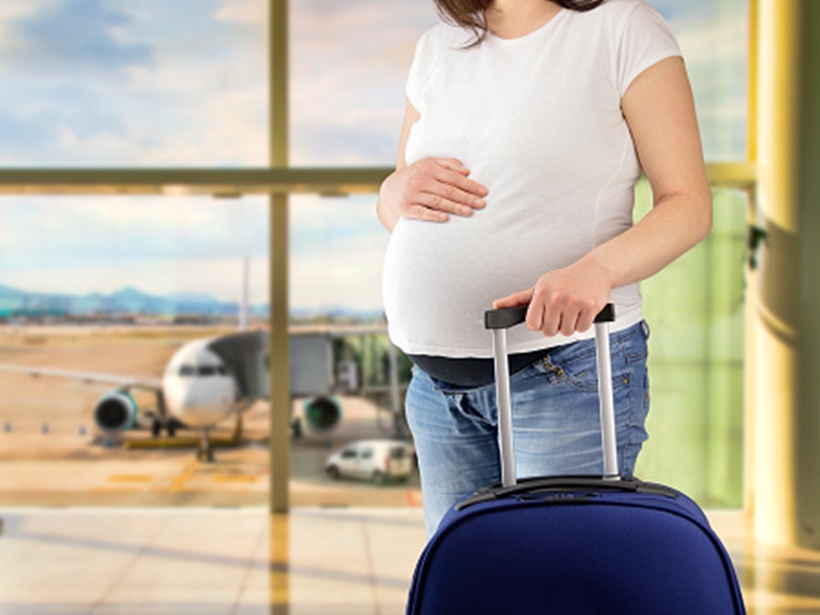
Travel by flight
Several airlines have specific guidelines for expectant mothers choosing to travel via flight. Some airlines permit pregnant mothers to fly till the end of 32 weeks of pregnancy. Air India, for instance, mentions in its website, “an expectant mother in good health may be accepted for transportation up to and including the 32nd week of pregnancy.” The airline also makes an exception for advanced pregnancy beyond 32 weeks with anticipation of normal delivery, whereby “the expectant mother will be accepted for travel up to and including the 35th week of pregnancy, i.e., up to, at least five weeks prior to the expected date of confinement. A medical certificate from the attending obstetrician must be obtained stating that she is fit to travel.” Cases of multiple and complicated pregnancy, however, are not accepted after the 32nd week.
Airlines like IndiGo or SpiceJet, on the other hand, allows expectant mothers till the end of 36 weeks of pregnancy, on showing a Fit to Fly certificate (dated not more than one or two weeks before the date of travel) obtained from the treating obstetrician, for travel between the 28th and 36th week.
Pregnant women usually frequent toilets which is why it is best to take the aisle seat in a flight. One can also book a special seat with more leg room to ensure a comfortable journey.
When onboard, keep yourself hydrated by drinking fluids. In case of a long-haul journey, taking a walk from time to time or flexing and extending ankles is advisable to ensure proper blood circulation.
Also Read: How to manage infants on long-haul flights
Travel by car
Shorter journeys are always preferable for pregnant women. In case the journey is too long, take a few breaks in between. Stretch your limbs for proper circulation in the body. If you are wearing a seat belt, fasten it around the hips to avoid undue pressure on the abdomen.
Travel by train
Hire a porter if you have a heavy bag or you need to carry your luggage for a significant distance up to the platform. Avoid getting down at halt stations each time. Try and book the lower berth in the train for greater ease in movement. And if you are taking a trip to the toilet, be careful about maintaining balance in the train.

Is Indian democracy dead? Subscriber Only

UPSC Key—26th March, 2024: Smart Meter National Programme, New Collective Subscriber Only

No Kuki candidates so far for ST-reserved Outer Manipur seat Subscriber Only

Kejriwal's arrest: Has BJP over-reached or is it a decisive Subscriber Only

What Pakistan thinks of India’s democracy index

How confidentiality became a bad word Subscriber Only

The changing IIM: Over 2 decades, more and more women Subscriber Only

UPSC Special: The Ultimate Package for Competitive Exam Preparation Sign In to read
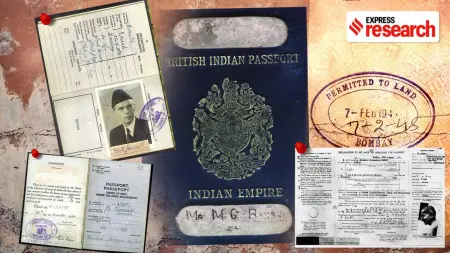
How citizenship was decided by makers of Indian Constitution Subscriber Only

How ads are becoming conversation starters Subscriber Only

Urvashi Kaur connects us to our roots Subscriber Only
- air travel safety
- Pregnant woman

Delhi HC to hear Arvind Kejriwal's plea against ED's arrest and remand in money laundering case related to excise policy. ED seeks 3 weeks to file response, Kejriwal's lawyer calls it a "delay tactic". Kejriwal arrested on March 21, remanded to custody till March 28.
- Mumbai News Live Updates: Cong former MP Sanjay Nirupam gives ultimatum to party, says ‘have options open’ 19 mins ago
- Arvind Kejriwal Arrest Live Updates: No money found in multiple ED raids, my husband will reveal truth before court on March 28, says Kejriwal’s wife 1 hour ago
- Lok Sabha Elections 2024 Live Updates: 'Working to ensure money looted from poor in Bengal, attached by ED returns to them', says PM Modi 3 hours ago
- Baltimore Bridge Collapse Live Updates: All 6 workers missing presumed dead, rescue operations suspended 3 hours ago

Best of Express

Buzzing Now

Mar 27: Latest News
- 01 NDA officer loses Rs 57 lakh in online share trading scam
- 02 Bar on political activities as bail condition violative of rights, SC tells Orissa HC
- 03 AAP MLAs among 260 detained as police stop march to PM home
- 04 280 booked for drunk driving during Holi
- 05 Who was Francis Scott Key, whose namesake bridge fell? His poem became ‘The Star-Spangled Banner’
- Elections 2024
- Political Pulse
- Entertainment
- Movie Review
- Newsletters
- Web Stories
- Logout Login
- Adventure Holidays
- Weekend Getaways
- Driving Holidays
- Travel News
Top Searches
Hyderabad Destination
Wildlife Parks
India Endangered Species
Maharashtra Temples
Oldest Wellness Retreats
Can you fly while pregnant? Here's everything you need to know
Times of India TIMESOFINDIA.COM / TRAVEL TRENDS , WORLD / Created : Dec 17, 2023, 16:33 IST
You're Reading
Embarking on air travel during pregnancy is generally safe, with considerations varying by trimester. Consult your healthcare provider for personalized advice. Most airlines permit flying during the first two trimesters, but restr … Read more
Embarking on air travel during pregnancy is generally safe, with considerations varying by trimester. Consult your healthcare provider for personalized advice. Most airlines permit flying during the first two trimesters, but restrictions may apply in the third trimester. Check individual airline policies and, if needed, obtain a medical certificate. Prioritize hydration, comfort, and movement during the flight. Read less
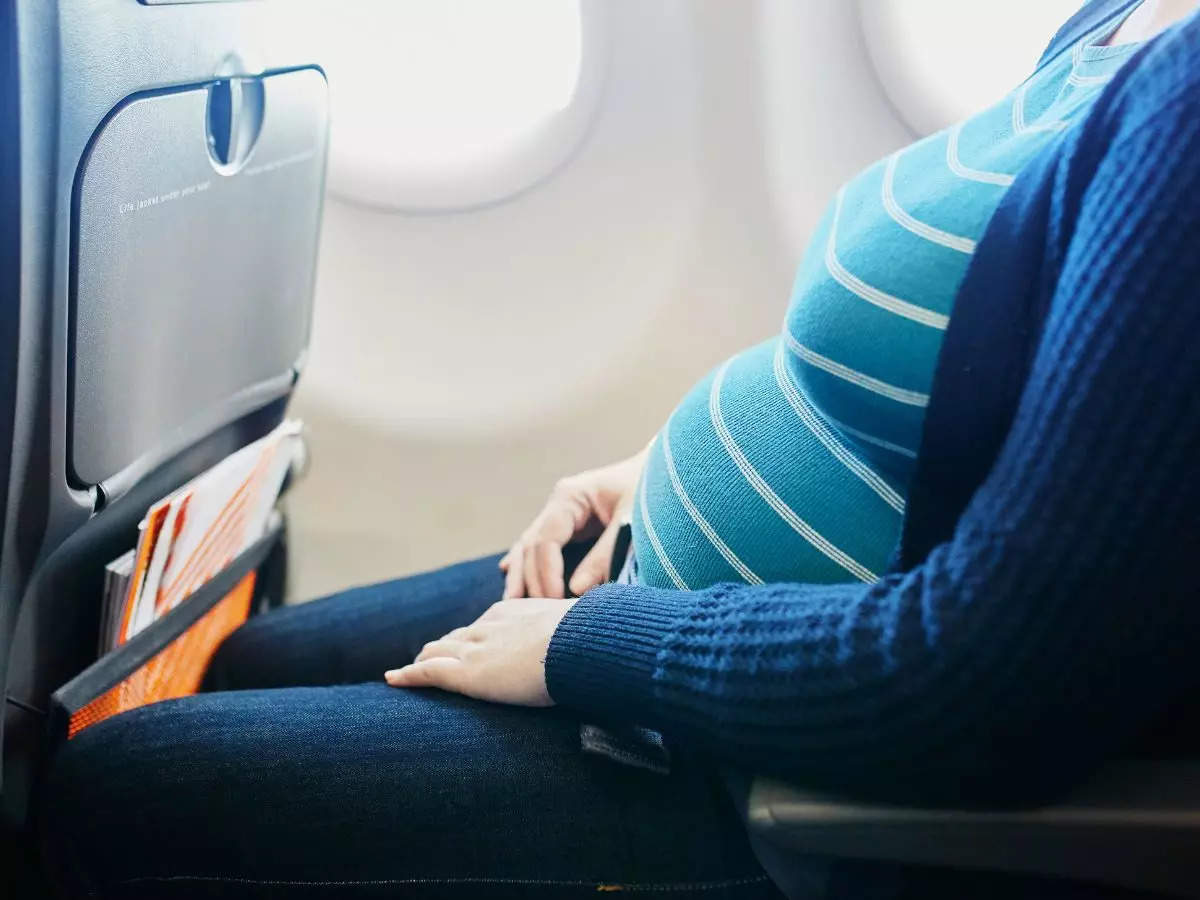
More from Travel News

World’s most visited UNESCO Heritage Sites
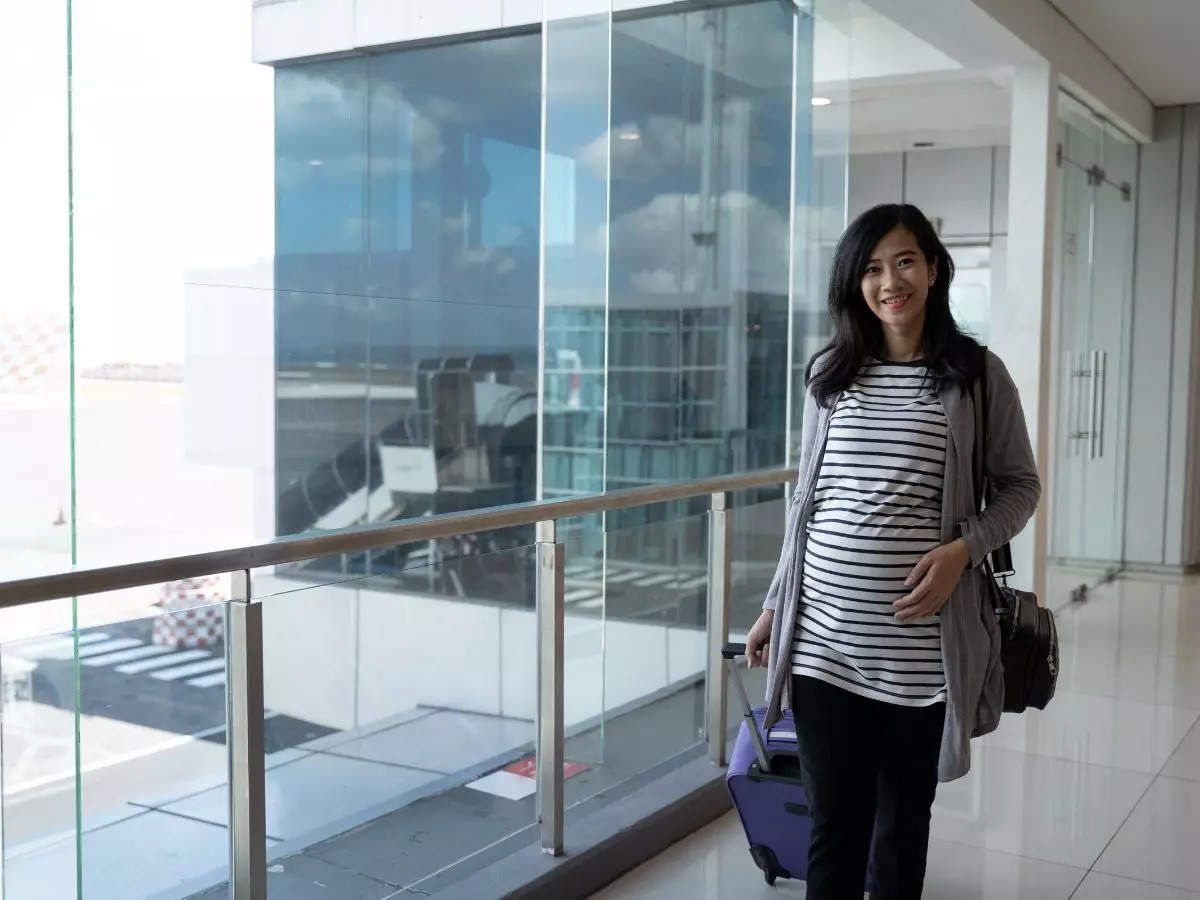
Comments (0)

Refrain from posting comments that are obscene, defamatory or inflammatory, and do not indulge in personal attacks, name calling or inciting hatred against any community. Help us delete comments that do not follow these guidelines by marking them offensive . Let's work together to keep the conversation civil.
Comments ( ) Sort: Newest UpVoted Oldest Discussed Down Voted closecomments

SIGN IN WITH
Or post without registration.

Visual Stories

Popular Galleries

Travel the world for these unique wildlife interactions TRAVEL TRENDS , WORLD

Goa beyond beaches: Unmissable wildlife experiences for nature lovers TRAVEL TRENDS , GOA

Kangana Ranaut get’s BJP ticket from her “Janambhoomi”: A look at must-visit attractions in Mandi, in Himachal
Trending stories.

Maharashtra: Two temple foundations unearthed during excavation

Travel the world for these unique wildlife interactions

10 richest cities in the world!

10 most endangered species in india to see before they're gone!

Visiting Hyderabad for IPL: These are city’s unmissable attractions
- 1 Can you fly while pregnant? Here's everything you need to know
- 2 Why are these bridges in Meghalaya called the Living Root Bridges?
- 3 Exploring America's top nightlife cities
- 4 Exploring Panchgani, a paradise in Maharashtra
- 5 Uttarakhand is a birding haven; here’s what to expect

THE DEFINITIVE GUIDE TO DESTINATIONS, ITINERARIES, THINGS TO DO, RESTAURANTS, NIGHTLIFE and LOTS MORE!
FOLLOW US ON
Places to visit.
- Places to visit in Bangalore
- Places to visit in Mumbai
- Places to visit in Delhi
- Places to visit in Goa
- Hotels in Goa
- Hotels in Jaipur
- Hotels in Shimla
- Hotels in Mumbai
Things To do
- Things to do in Goa
- Things to do in Mumbai
- Things to do in Bangalore
- Things to do in Delhi
Travel Inspiration
- Visa on arrival for Indians
- Honeymoon Places in india
- Hill Stations in India
- Weekend getaways in Mumbai
- Weather in Delhi
- Weather in Chennai
- Weather in Bangalore
- Weather in Mumbai
Best Beaches
- Goa Beaches
- Mumbai Beaches
- Pondicherry Beaches
- Kerala Beaches
- Restaurants in Bangalore
- Restaurants in Chennai
- Restaurants in Pune
- Restaurants in Jaipur
- Hill Station near Delhi
- Winter trip to Ladakh
- Places to visit in Kerala
- Winter Honeymoon Destinations
- UK visa guide for Indians
- Winter Trip to Manali
- Vaishno Devi Yatra
- Special Train Ticket Booking
- HP inter-state Bus
- Honeymoon Destinations India
Latest News
- 5 countries that offer easy work visas for Indians
- Assam: Two new species identified in Kaziranga National Park; what are they?
- Maharashtra: Two temple foundations unearthed during excavation in Ambajogai

Congratulations!
You have been successfully added to the mailing list of Times of India Travel. To complete the subscription process, kindly open your inbox and click on the confirmation link which has been emailed to you.
Share with friends
Thank You for sharing! Your friend will receive the article link on email mentioned.
- (For more than one recipient, type addresses separated by commas)
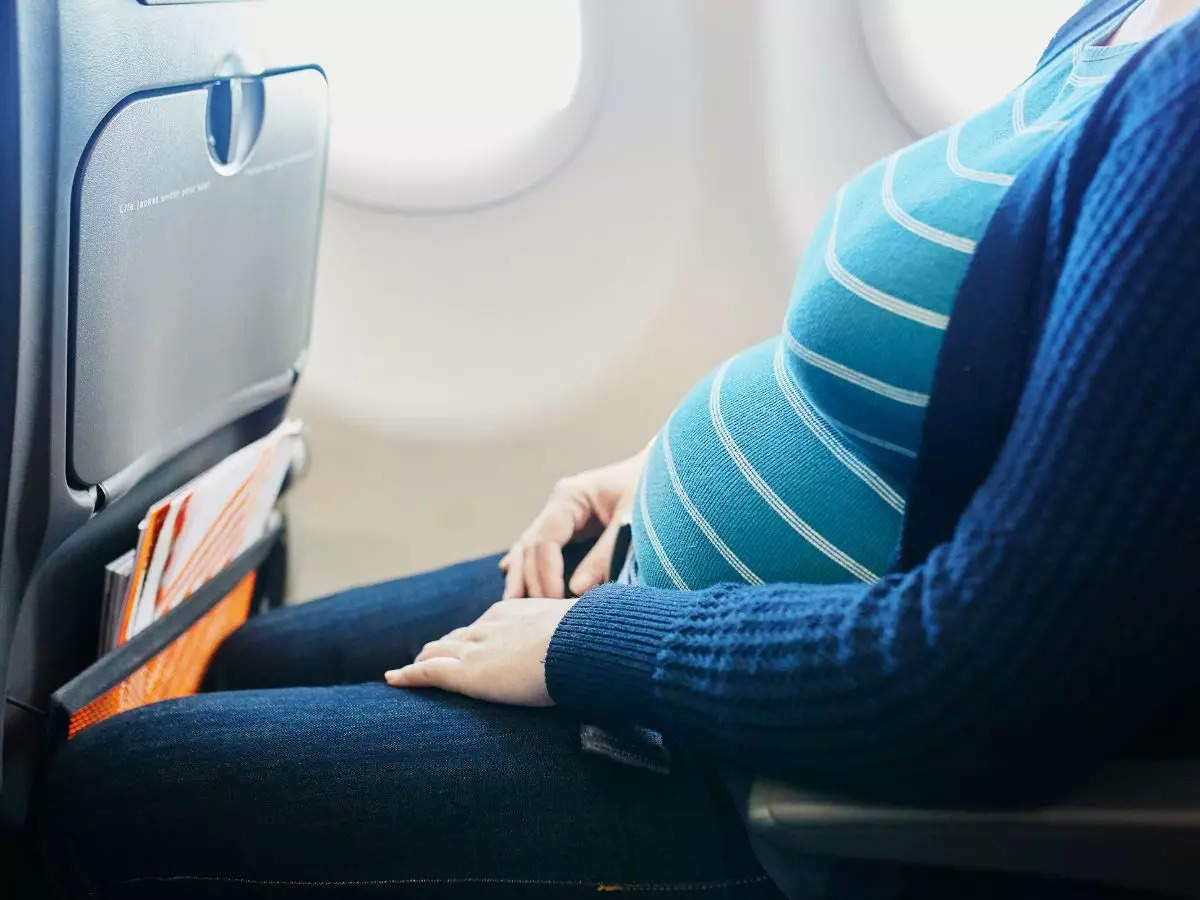
Embarking on air travel during pregnancy is generally safe, with considerations varying by trimester. Consult your healthcare provider for personalized advice. Most airlines permit flying during the f...
Appointments at Mayo Clinic
- Pregnancy week by week
Is it safe to fly during pregnancy?
Generally, air travel before 36 weeks of pregnancy is considered safe for people who aren't dealing with any pregnancy problems. Still, if you're pregnant, it's a good idea to talk with your health care provider before you fly.
Your provider might suggest that you not fly if you have certain pregnancy complications that could get worse because of air travel or that could require emergency care. Examples include a history of miscarriage or vaginal bleeding, severe anemia, and high blood pressure or diabetes that's not well controlled. If you had preeclampsia during a previous pregnancy — a condition that causes high blood pressure and extra protein in urine — flying may not be advised. The same is true if you're pregnant with twins or other multiples.
Tell your provider how far you are flying, as the length of the flight might make a difference. Also, be aware that some airlines may not allow pregnant people on international flights. Check with your airline before you make travel arrangements.
After 36 weeks of pregnancy, your health care provider may advise against flying. And some airlines don't allow pregnant people to fly after 36 weeks. The airline also may require a letter from your health care provider that states how far along in your pregnancy you are and whether flying is advised.
If your health care provider says it's okay for you to fly, and your plans are flexible, the best time to travel by air might be during the second trimester. The risks of common pregnancy emergencies are lowest during that time.
When you fly:
- Buckle up. During the trip, keep your seatbelt fastened when you are seated, and secure it under your belly.
- Drink plenty of fluids. Low humidity in the airplane could cause you to become dehydrated.
- Avoid gassy foods and drinks before you fly. Gases expand during flight, and that could make you uncomfortable. Examples of foods and drinks to avoid include broccoli and carbonated soda.
- Think about medical care. Plan for how you'll get obstetric care during your trip if you need it. Bring copies of your medical information in case you need care while you're away.
Blood clots
Air travel can raise the risk for blood clots in the legs, a condition called venous thrombosis. The risk is higher for pregnant people. Moving your legs may help prevent this problem. Take a walk up and down the aisle every hour during the flight. If you must remain seated, flex and extend your ankles from time to time. In general, it's best to avoid tightfitting clothing, as that can hinder blood flow. Wearing compression stockings can help with blood circulation during a long flight.
Radiation exposure linked to air travel at high altitudes isn't thought to be a problem for most people who fly during pregnancy. But pilots, flight attendants and others who fly often might be exposed to a level of radiation that raises concerns during pregnancy. If you must fly frequently during your pregnancy, talk about it with your health care provider.
Mary Marnach, M.D.
There is a problem with information submitted for this request. Review/update the information highlighted below and resubmit the form.
From Mayo Clinic to your inbox
Sign up for free and stay up to date on research advancements, health tips, current health topics, and expertise on managing health. Click here for an email preview.
Error Email field is required
Error Include a valid email address
To provide you with the most relevant and helpful information, and understand which information is beneficial, we may combine your email and website usage information with other information we have about you. If you are a Mayo Clinic patient, this could include protected health information. If we combine this information with your protected health information, we will treat all of that information as protected health information and will only use or disclose that information as set forth in our notice of privacy practices. You may opt-out of email communications at any time by clicking on the unsubscribe link in the e-mail.
Thank you for subscribing!
You'll soon start receiving the latest Mayo Clinic health information you requested in your inbox.
Sorry something went wrong with your subscription
Please, try again in a couple of minutes
- Allergy medications during pregnancy
- AskMayoExpert. Health considerations for air travelers: Pregnancy considerations. Mayo Clinic; 2022.
- Air Travel During Pregnancy: ACOG Practice Bulletin No. 746. American College of Obstetricians and Gynecologists. https://www.acog.org/clinical/clinical-guidance/committee-opinion/articles/2018/08/air-travel-during-pregnancy. Accessed Dec. 1, 2022.
- Ram S, et al. Air travel during pregnancy and the risk of venous thrombosis. American Journal of Obstetrics and Gynecology. 2022; doi:10.1016/j.ajogmf.2022.100751.
Products and Services
- A Book: Taking Care of You
- A Book: Obstetricks
- Available Solutions for Prenatal Nutrition from Mayo Clinic Store
- A Book: Mayo Clinic Guide to a Healthy Pregnancy
- Ankle swelling during pregnancy
- Antibiotics and pregnancy
- Aspirin during pregnancy
- Pregnancy back pain
- Falling during pregnancy: Reason to worry?
- Fetal ultrasound
- Flu shot in pregnancy
- Headaches during pregnancy: What's the best treatment?
- Iron deficiency anemia during pregnancy: Prevention tips
- Leg cramps during pregnancy
- Pregnancy acne
- Pregnancy and fish
- Pregnancy constipation
- Pregnancy diet: Essential nutrients
- Pregnancy due date calculator
- Pregnancy exercises
- Pregnancy nutrition don'ts
- Pregnancy stretches
- Pregnancy weight gain
- Pregnant. Now What Happens?
- Prenatal testing
- Prenatal vitamins and pregnancy
- Sex during pregnancy
- Twin pregnancy
- Vaccines during pregnancy
- Vaping during pregnancy
- Working during pregnancy
- X-ray during pregnancy
Mayo Clinic does not endorse companies or products. Advertising revenue supports our not-for-profit mission.
- Opportunities
Mayo Clinic Press
Check out these best-sellers and special offers on books and newsletters from Mayo Clinic Press .
- Mayo Clinic on Incontinence - Mayo Clinic Press Mayo Clinic on Incontinence
- The Essential Diabetes Book - Mayo Clinic Press The Essential Diabetes Book
- Mayo Clinic on Hearing and Balance - Mayo Clinic Press Mayo Clinic on Hearing and Balance
- FREE Mayo Clinic Diet Assessment - Mayo Clinic Press FREE Mayo Clinic Diet Assessment
- Mayo Clinic Health Letter - FREE book - Mayo Clinic Press Mayo Clinic Health Letter - FREE book
- Healthy Lifestyle
- Expert Answers
- Air travel during pregnancy Is it safe
Let’s celebrate our doctors!
Join us in celebrating and honoring Mayo Clinic physicians on March 30th for National Doctor’s Day.
Pregnancy Travel Tips
Medical review policy, latest update:, can you travel while pregnant , read this next, when should you stop traveling while pregnant, how should you prepare for a trip during pregnancy, what do pregnant women need to know about travel and the zika virus, travel tips for pregnant people, when should you seek medical care while traveling during pregnancy.
While traveling during pregnancy is generally considered safe for most moms-to-be, you’ll need to take some precautions before making any plans — and get the green light from your practitioner first.
What to Expect When You’re Expecting , 5th edition, Heidi Murkoff. WhatToExpect.com, Zika Virus and Pregnancy , October 2020. WhatToExpect.com, What to Know About COVID-19 if You’re Pregnant , February 2021. American College of Obstetricians and Gynecologists, Travel During Pregnancy , August 2020. Johns Hopkins Medicine, Traveling While Pregnant or Breastfeeding , 2021. Centers for Disease Control and Prevention, COVID-19 Travel Recommendations by Destination , May 2021. Centers for Disease Control and Prevention, Pregnant and Recently Pregnant People , May 2021. Centers for Disease Control and Prevention, Pregnant Travelers , December 2020. Centers for Disease Control and Prevention, Travel: Frequently Asked Questions and Answers , April 2021. Centers for Disease Control and Prevention, COVID-19 and Cruise Ship Travel , March 2020.
Jump to Your Week of Pregnancy
Trending on what to expect, signs of labor, pregnancy calculator, ⚠️ you can't see this cool content because you have ad block enabled., top 1,000 baby girl names in the u.s., top 1,000 baby boy names in the u.s., braxton hicks contractions and false labor.
You are being redirected to an external/third party website. Please note that IndiGo cannot be held responsible for content and privacy policies on such website.
- Select Flight
- Fare Difference
- Seat Selection
Get Members Benefit.
Get Members Benefit. Sign Up
- 6E Rewards NEW
- Search FAQs
Select Language
Please select your preferred language
Special/Disability Assistance
Flying Solo Service
3. Pregnant Women
4. Safety Assistants
5. Customers with Sensory Impairment
(A)Visual Impairment
(B)Hearing Impairment
(C)Visual & Hearing Impairment
6. Service Dog
7. Mobility Assistance
8. Wheelchair users or Customers using wheelchairs, Crutches / braces / other prosthetic devices
9. Spinal Support Equipment (SSE)
10. Traveling with broken limbs
11. Passengers with Psychiatric or Emotional disorders
12. Passengers having Autism or Intellectual Disability
13. Internal Devices
14. Portable oxygen concentrators( POC)
15. Customers with certain adverse medical conditions
16. Customer Grievance Redressal
17. Frequently asked Questions
Seating accommodation & aircraft accessibility for passengers with a disability:
- We will do our best to allocate you a seat that is most suitable to your needs, movable armrest for easy accessibility to the seats However, in order to meet the safety requirements of the DGCA, passengers with mobility issues which make it unsafe to facilitate aircraft evacuations will not be given a seat in a location where they would obstruct emergency exits, impede the crew in their duties, obstruct access to emergency equipment or hinder aircraft evacuation in case of an emergency. To allow us to provide the best assistance, please provide us with as much information as possible at the time of your booking and or at the time of check-in
Lavatories:
- A lavatory with a single panel door and additional grab bar is available on all our aircraft. Our cabin crew can provide assistance moving to and from the lavatory door(same as above), but will not be able to assist the customer inside the lavatory.
For safety reasons, children above the age of seven (7) days and under the age of two (2) years as on the date of travel are regarded as Infants. In the event of a failure to produce a valid proof of age for the Infant, full fare as applicable on the date of travel will be payable for the Infant and the infant will be allowed to travel only subject to availability of seats.
- No extra seats may be booked for Infants.
- Infants cannot travel in their own seat and must be seated in an adult's lap.
- A maximum of one infant per adult is allowed.
- For infants not occupying a seat a fee, as mentioned in Annexure A, per sector is applicable and is inclusive of all taxes including but not limited to applicable service tax, fees and surcharges.
Baggage allowance
- Infants are permitted a baggage allowance for hand Baggage only for a maximum weight of 7Kgs
Children above the age of two (2) and below the age of twelve (12) years are regarded as Minors. Children aged between the ages of 2 and 5 must be accompanied by a companion aged 18 years or more.
A child's journey under Flying Solo Service
As a child, travelling alone can be an exciting experience but a parent would need to know and be assured that the child will be taken care of.
IndiGo may, at its sole discretion, accept unaccompanied minors, that is, children aged above5 and below 12 upon payment of an additional fee as mentioned in Annexure A per Sector:
At departure
- Please make the child available at the airport at least 2 hours prior to departure.
- A parent or guardian is required to complete a signed form ( click here to download the form) at the point of check-in at each departure airport prior to travel, which must include the name and contact numbers for a parent or guardian (above the age of 18) who will meet the unaccompanied minor at the point of arrival;
- Valid photo-ID for both the unaccompanied minor and the parent or guardian is required at the point of check-in;
- A staff member will take the child to the aircraft where our cabin crew will then look after them.
- The parent or guardian must remain at the airport until the flight has departed.
- During the flight our cabin crew will keep an eye on the child and will make sure that they have everything they need.
- Do not worry about the meal, as it is included on our Flying Solo program.
- To make sure that the child has a comfortable flight, the parent is requested to pack medication, warm clothing and a favorite toy or game in their hand baggage.
Transit/Transfer
- If the stopover at transfer station is less than 6 hours and if the child is booked through out on IndiGo, we shall be able to accept the child under Flying Solo Services.
- If the stopover at transfer stations is more than 6 hours and/or involves night halt and/or transfer is on other airline except IndiGo, we shall not be able to accept the child under Flying Solo services. In such cases child must be accompanied by someone who is above the age of 18 years in age.
Upon arrival
- When the flight arrives, our ground staff will accompany and assist the child through the airport arrivals process.
- We will only release the child to the care of the nominated adult, after checking their photo ID as per the details mentioned in the form
- Please be available at the arrival hall at least 30 mins prior arrival to receive the child.
GUIDELINES FOR PREGNANT LADIES FLYING WITH INDIGO
Expectant mothers (relevant cases) are required to provide fit to fly certificate from treating doctor stating –.
- WEEKS OF PREGNANCY
- EXPECTED DATE OF DELIVERY
- COMPLICATIONS IF PRESENT
PREGNANT LADIES BEYOND 36 WEEKS ARE NOT PERMITTED TO FLY
A Safety Assistant is any able-bodied person who assists the customer with disability to exit the aircraft in case of an emergency evacuation, or to establish communication with cabin crew for the purpose of the required safety briefing.
Who can be a Safety Assistant
- The safety assistant shall be at least 18 years old, physically and mentally able and willing to evacuate the disabled customer in case of an emergency
Seating of the Safety Assistant
- The Safety Assistan will be seated next to the customer, in order to assist in case of an emergency. If a safety assistant is accompanying several customers with disability, the safety assistant will be seated in the same row as the customer with disability. In case seats are not available in the same row, then the safety assistant is seated in the row immediately in front or behind of the customer with disability.
Examples of requirement of a safety assistant:
- Customers traveling in a stretcher - The safety assistant must be a medical / paramedical escort. In selected cases IndiGo’s internal physician may permit a non-medical Safety assistant.
- Customers with mental disability who are unable to comprehend or respond appropriately to safety instructions, including the regulatory safety briefing and any other safety related instructions provided in the aircraft.
- Customers with a mobility impairment so severe that the person is unable to physically assist in his or her own evacuation of the aircraft in case of an emergency.
- Customers with severe hearing , vision impairments and speech impairment , (all together) - if the customer cannot establish some means of communication with the cabin crew that is adequate both to allow transmission of the regulatory safety briefing, and to enable the customer to assist in his or her own evacuation of the aircraft in the event of an emergency
- Any other disability which IndiGo, in its sole discretion decides may affect the safety of the customer while on board an aircraft
Customer Responsibility
We at IndiGo are highly committed to passengers’ safety and convenience and making the best of efforts to ensure that all our customers experience the finest of services on board our planes. Having said that, it is pertinent to mention here that our airline is still in an evolving stage. We have learnt to interact with persons with disability flying with us, however, we are still learning, constantly exploring, and finding ways to serve our customers better. At this stage, we are trying our best to gain expertise and competence, thereby enhancing our teams’ awareness & customer handling skills. In order to make your journey comfortable, we solicit passengers’ support and cooperation. For a passenger travelling alone, should be able to perform the following activities independently:
Requirements:
- Fasten and unfasten seat belt?
- Take out and put on the lifejacket?
- Leave the seat and get to an emergency exit (this does not need to be by walking)?
- Put on an oxygen mask?
For certain passengers we express our special concern and insist that they travel with a companion . Generally, the passengers who are likely to need a companion are those who:
- Have a severe learning or cognitive challenge which prevents them from understanding or reacting to safety instructions
- Are hearing and visually impaired
- Have a challenge that prevents them from moving without assistance to reach an emergency exit.
5.Customers with Sensory Impairment –
(A) Visual Impairment
Pre-requisite
- If assistance is required within the airport, customer or his representative shall intimate IndiGo about the type of assistance required prior to the departure.
At the airport
- Do note that our boarding gates close 25 mins (domestic) and 45mins (international) prior to the scheduled departure time, post which boarding is not allowed.
- Also note since some the airports are silent airports there would not be any sort of announcements made.
- The customer is welcome to board the aircraft at leisure; however if requested to the staff at the departure gate, the customer will be able to board first, the staff at the boarding gate shall assist you in boarding first.
Every IndiGo aircraft comes equipped with Safety Briefing Cards printed in Braille for our customers who have vision disabilities.Our cabin crew will read the meal menu options, identify food items and placement on the tray and assist with opening the food package upon request. . Our cabin crew will not be able to provide any assistance in feeding such customer
- Due to safety regulations, the customer with visual impairment will not be allocated an exit row seat.
(B) Hearing Impairment
- IndiGo would request Customers with Hearing Impairment to check-in early for their flight for a hassle free experience.
- If customer declares independence in mobility within the airport and doesn’t require any staff for assistance, the customer must ensure to be present at the designated boarding gate at the boarding time mentioned on their boarding pass. Also note most of the airports are equipped with electronic flight display, however, the nearest IndiGo staff can always be contacted for any assistance required.
- Do note that our boarding gates close 25 mins ( domestic) and 45mins (international) prior to the scheduled departure time, post which boarding is not allowed.
- The customer is welcome to board the aircraft at leisure; however if requested to the staff at the departure gate, the customer will be able to board first. The staff at the boarding gate shall assist you in boarding first.
- Due to safety regulations, the customer will not be allocated an exit row seat.
(C) Visual and Hearing Impairment
- If assistance is required within the airport, customer or his representative shall intimate IndiGo about the type of assistance required at least 48 hours prior to the departure.
- For customers’ safety, they will need to travel with a safety assistant if they need help to do any one of the following:
✓ Fasten and unfasten your seat belt
✓ Take out and put on your lifejacket
✓ Leave your seat and get yourself to an emergency exit (this does not need to be by walking)
✓ Put on an oxygen mask
✓ Establish communication with crew with regards to safety briefings and react to safety instructions
If you are required to travel with a companion, IndiGo will sell them a ticket at the same fare as that paid by the first passenger, even if rates have increased in the meantime. It may also be possible to find another passenger on the flight willing to take the role of an accompanying person for emergency purposes but this cannot be guaranteed
6.Service Dogs :
When to inform:
- Customers with sensory impairment intending to travel with their guide dog, should make their reservation via the IndiGo call centre and provide us notice of at least 48 hours prior to departure, that a guide dog will be travelling.
Seating of the guide dog
- Please note that guide dogs for our sensory impaired customers shall not occupy any seat.
- Customers with guide dog will be seated on the first row.
Documentation Required
- The customer must produce complete and valid documentation including but not limited to identification cards to prove that the guide dog is a service animal and has all valid permissions including confirmation that it is trained from an appropriate institution
- The certificate of vaccination of the guide dog shall be produced at the time of check-in.
Hygiene/travel requirements of a guide dog
- The customer is required to bring a moisture absorbent mat, to place it under the guide dog. Further, the guide dog should be properly trained, restrained, muzzled and vaccinated
- A guide dog may be denied boarding or removed from the flight if, IndiGo in its sole discretion decides that the animal cannot be contained by the customer or otherwise exhibits behavior that poses a threat to the health or safety of others on board.
- Customer shall be fully responsible for the guide dog. A meet and assist service can be provided, if assistance is required at departure and on arrival, on prior request
Only for International:
- If travelling into India or out of India, the guide dog must meet the requirements of the destination country
7. Mobility Assistance:
- IndiGo would be more than happy to provide a wheelchair as per your requirement. In order to ensure the service meets your needs, our reservation team or the airport staff may ask you some questions to determine the level of assistance you require.
- IndiGo wheelchair service is provided with an attendant at no additional charge to you. The attendant will assist in transporting you within the airport area and to the gate or the aircraft door (depending on the airport facilities).
- Our team is trained in transferring techniques and can assist if you are unable to transfer by yourself from the wheelchair to/from your seat;
- Whilst we will do everything we can to help our customers to their onward flight, they are requested to be aware that there might be a delay in assisting them during busy periods.IndiGo shall not be liable for any such passenger missing onward flights, we would always advise them to factor in delay times when making their travel plans.
- Our employees are trained to assist our customers with disabilities and for any sorts of limitations, we offer a wide variety of Special/Disability Assistance.
- Please be aware that there might be unpredictable circumstances such as weather or mechanical problems that may call for a last minute unavoidable change, but we will do our best to accommodate your needs.
- If you are travelling in a group of 10 or more people and require wheelchairs, please contact 0124 6613838 at least 48 hours before scheduled departure
- Please contact us either through this web site or by contacting our agents on 0124 6613838
IndiGo does provide the following facilities to its Customers with reduced mobility:
- Assistance in moving to and from seats; and
- Help in preparation for eating.
However, we express our inability to provide customers with any assistance for personal care needs on-board, such as, eating/drinking, administration of medications, assistance inside the lavatory, or other personal care needs. If assistance is required with any of these, we recommend a Safety Assistant.
8. Wheelchair users or Customers using wheelchairs, Crutches / braces / other prosthetic devices:
Before travel
- We want our customers to be as comfortable as possible on their IndiGo flight. Our staff will be pleased to discuss their needs, so call us and we'll help you plan your travel
Traveling with own wheelchair
- If customers wish to check-in their own wheel chair, IndiGo shall provide assistance to dismantle and/or reassemble the wheelchair under the supervision of the customer. However IndiGo shall not be liable for any damage arising while handling the wheelchair. Such checked in wheelchair will be returned to the customer at the destination airport
- If the customer wishes to use their own wheelchair at the airport, they are permitted to do so up to the aircraft, whereupon it will be stored in the hold area.
- In the event of loss or damage, mobility aids or any equipment relating to the disability which are placed into the checked are luggage is not covered for anything more than the maximum liability under IndiGo’s Conditions of Carriage.
- We recommend suitable travel insurance for any equipment carried along
- Customers are allowed to use their own crutches, braces and / or other prosthetic devices up to the aircraft, and may board withsuch items as hand baggage, provided the customers are dependent on them.
- Customer with a disability may use their own manual powered wheelchair till the aircraft door
- Unfortunately electronic powered wheelchair(s) with a wet-cell battery shall not be accepted since it’s corrosive in nature and is considered to be a ‘’Dangerous Good’’
- Unfortunately electronic powered wheelchair(s) with lithium or non spillable battery shall not be allowed beyond the check-in counter, due to security reasons
- Electronic wheelchairs will be dismantled at our check-in counters and the customer needs to carry something to seal the battery terminals to avoid damage to the battery
Airport Wheelchairs
- We have wheelchairs available for use at all airport locations to assist with transportation from check-in to the boarding gate, making connections (if applicable) and from the aircraft to the arrivals hall at the destination. Customers can request this service when making their booking, and upon arrival at the airport they can notify one of our airport service agents about their wheelchair requirement. For an hassle free experience customers shall notify IndiGo at least 48 hrs prior departure
Safety Assistant
If a customer is travelling without safety assistant, IndiGo shall be happy providing below mentioned assistance:
✓ will be able to extend a meet and assist service to the customer to assist in boarding, deplaning, flight connections and check-in / transfer / reclaiming of checked-in bags.
✓ stowing their hand baggage
✓ opening any parts of customer’s on board meal.
✓ on board individual safety briefings if requested by customer
IndiGo regrets its inability to assist with following,
✓ assist the customer with personal care and toileting needs before, after and during the flight.
At destination
- If the wheelchair has been stowed in the hold, we'll make every effort to return it to the customer as close to the aircraft door as possible. If this is not possible, we will make sure there is a wheelchair available to assist customer to the baggage reclaim area
We can arrange assistance between the gate and the arrivals hall if the customer would like this service. Depending on the airport, this will either be by electric buggy, airport wheelchair or accessible buses.
9. Spinal Support Equipment (SSE):
- Customers must bring their own spinal support equipment and should be fully responsible for installation, usage and removal.
- Customer-supplied spinal support equipment will be carried free of charge.
- If you are planning to travel with Spinal Support Equipment, we recommend that you please contact us on 0124 6613838 , at least 7 (seven) working days prior to departure and inform us of your SSE specifications.
- Our Engineering team will then check to ensure that your equipment can be accommodated safely in the aircraft.
10. Travelling with broken limbs
- Customers travelling with broken or fractured limbs in plaster are required to travel with a ‘fit to fly’ certificate. The cast must be at least 48 hours old as a fresh fracture could swell inside the cast (Except in cases of a Bivalve Cast or a Post cast Slab)
- Customers who are unable to bend their leg at the knee joint for any reason, are required to purchase additional seats to enable the leg to be elevated. Window and middle seats shall be blocked for such customers. The customer will not be permitted to place his/her leg in a position that will obstruct the movement of our crew or other customers. Customers travelling with a cast below the knee, may only require one seat.
11. Passengers with Psychiatric or Emotional disorders:
- Passengers with psychiatric or emotional disorders shall always travel with a safety assistant.
- The safety assistant shall carry the treating physician’s certificate along with a prescription for a sedative medicine, which may be administered by the attendant, prior to commencement of travel or as may be required en-route.
12. Passengers having Autism/ Intellectual disability/Dementia / Alzheimer's and Down syndrome :
- Customerswith Autism/Intellectual disability/Dementia/Alzheimer's and Down syndrome need to book their flights at least 48hrs prior departure by call our call centre at 09910383838
- While making the reservation, please advise us about your specific requirements and the best way to approach and assist in travel
- Autism/ Intellectual disability/Dementia / Alzheimer's and Down syndrome customers will be given time to settle in their seat before other customers board the aircraft.
- Our customer service and cabin crew team will provide all the assistance required other than the ones provided by a safety assistant
IndiGo offers Assistance, upon request, from the ticket counter till the aircraft seat shall be provided . In addition, meeting their family member at the gate upon arrival is also available. These requests need to be made at the ticket counter at check-in. The name of the person picking up the customer must be communicated at the time of check-in as well.
13. Internal Medical Devices:
- If you are travelling with an internal medical device, such as a pacemaker or a defibrillator, kindly inform us while making the reservation and also at the airport, to the security personnel conducting your screening, before the process begins.
14. Portable oxygen concentrators ( POC)
Only Portable Oxygen Concentrator (“POC”), approved by Federal Aviation Administration (“FAA”) is permitted on board IndiGo flights either as checked-in or hand baggage, free of cost, subject to following conditions being met:
- A request for carriage or use of the POC on board being made by the Customer to IndiGo a minimum forty eight (48) hours in advance from the scheduled departure time;
- POC should not cause any interference with the electrical, navigation or communication equipment on board;
- Passenger carrying the POC on board must comply with all security requirements and instructions communicated by the Crew, from time to time;
- Passenger alone will be solely responsible for packing, assembling, dismantling or facilitating administration of POC both on ground and on board. IndiGo will under no circumstances be liable or responsible for the same.
- Notwithstanding anything contained herein, IndiGo, in its sole discretion, reserves the right to refuse carriage of the POC, if it is likely to endanger the safety of the aircraft or of any person;
If POC is to be carried as checked-in baggage:
- For safety purposes, Customer must ensure that the POC prior to check in is empty and free of pressure. Thus, if the POC was used before coming to the airport, then the Customer must to reset the POC to avoid any residual oxygen in the equipment;
- If POC operates on lithium battery, battery should be removed and carried by Customer as hand baggage. If POC operates on any other type of battery, battery should be removed and packed separately in such a way that battery terminals do not come in contact with any metal objects. Carriage of such batteries will further be subject to applicable regulatory requirements including but not limited to those mentioned under the Aircarft (Carriage of Dangerous Goods) Rules, 2003, International Civil Aviation Organization (ICAO) Technical Instructions for the Safe Transport of Dangerous Goods by Air, the International Air Transport Association (IATA) Dangerous Goods Regulations.
If POC is to be carried as hand baggage:
- Customers carrying/using the POC on board shall be assigned only a window seat, except on rows 1,12 & 13. Such customers shall not be seated on middle or aisle seats. IndiGo reserves rights to change seats of such customers, if required.
- Such customers must be capable of seeing, hearing and understanding the POC device warnings and should be in a position to take appropriate action, without assistance, in response to those warnings;
- During taxi, take-off and landing the POC, if being used must be stowed under the seat in front.
During an unlikely event of decompression(means in case of decrease of cabin pressure) Passengers must wear the oxygen mask from the overhead panel as a primary source of oxygen and not their POC, as the oxygen mask would ensure a continuous flow of oxygen and would also minimize the chance/ effects of decompression sickness.
IndiGo’s has a list of FAA approved POCs, such list is indicative and not exhaustive. Please call our call centre or airport operation to clarify if your POC is approved for carriage in our aircraft
15. Customers with certain adverse medical conditions:
- Customers who are ailing from any particular medical condition can travel on IndiGo after giving prior information regarding his/her medical condition, at least 72 hours prior to the scheduled departure of the flight, as per the medical form provided on IndiGo Website, in order for IndiGo to provide complete assistance to such Customer.
- The Customer must also inform IndiGo regarding any hospitalization requirement upon arrival.
- In case a Customer will be accompanied by a safety assistant during travel then his/her name and contact details must also be shared with IndiGo.
- IndiGo would want to mention that its cabin crew are not authorized to give special assistance (e.g. lifting etc.). Further they are trained only in first aid and are not permitted to administer any injection or to give medication. IndiGo neither facilitates nor allows carriage or usage of oxygen cylinders on board.
A customer who has agreed to this Conditions of Carriage agrees and understands that he/she has accepted to undertake the travel on IndiGo on his/her own will and volition and further agrees that IndiGo will not be responsible for any liability other than the liability as specified in the Conditions of Carriage.
Customers requiring stretchers
- To make a Booking for such Customers, requests need to be placed no later than 72 hours prior to the scheduled time of departure of the flight.
- Please note Stretchers are not permitted on any of our connecting flights.
- Customers are required to take a print-out of the IndiGo medical form click here , available on the Website, and have the same filled out by the Customer’s treating physician, prior to making the Booking, and then fax the same to 0124-4068536.
- Customers are required to include their Booking confirmation / PNR number on the fax and the travel Itinerary to ensure correct processing. Based on an assessment of IndiGo’s internal physician, a Booking confirmation will be communicated to the Customer within 24 hours of receipt by IndiGo of the fax.
- Please note that IndiGo reserves the right to have an IndiGo medical representative meet the Customer at the airport on the date of travel to determine the Customer’s medical fitness for travel on that date. The applicable Charges will be for nine (9) seats at the prevailing fare, plus a handling fee as mentioned in Annexure A .
- Our customer service and cabin crew team will provide all the assistance required other than the ones provided by asafety assistant
At IndiGo we strive for utmost customer satisfaction and the teams have been trained to deliver highest level of customer satisfaction. However in the event should you feel dissatisfied about something please don’t
hesitate to reach out to us so that we can make things right if they weren’t. We are reachable to you in more than one way:
Call Center: Call 9212783838
Nodal Officer: Siddharth Biswakarma Email: [email protected] Appellate Authority: Priyaah Sundaraam Email: [email protected] Contact: +91 124 661386 [email protected]
Our Customer Services Manager at various airports shall be more than happy to help you.
17. Frequently Asked Questions
1. I am visually impaired and will be carrying a white cane with me, how shall I inform the airlines? Kindly contact us at 0124 6613838 if you have any assisting devices. We will find out the best way to store them so they arrive without damage. At the airport, please let the check-in personnel know that you may need extra time to board the plane. After the plane has landed, kindly wait in the plane until you see or have your assisting device, wheelchair, etc.
2. I am visually impaired, can I travel with my guide dog? If yes, what are the formalities involved? We will make special arrangements for your Guide/Assistance Dog, to ensure they are able to travel with you in the aircraft cabin. Certified Assistance Dogs for blind passengers can travel free of charge in the aircraft cabin. Notify us at 0124 6613838 when travelling with a Guide/Assistance Dog at the time of booking as the number carried on each aircraft is restricted (please refer to our disability assistance page for more information).
3. I will be carrying my own motorized wheelchair, can you advise how shall I go about it? We will require the dimensions, weight, type of tires, type of batteries, etc. of your wheelchair. We suggest you carry spare batteries. Wheelchair BATTERY may be disconnected due to safety reasons and wet cell batteries are not allowed to be carried on an IndiGo flight. Kindly inform your travel agent/us about any assisting devices you may need or already have like canes and crutches.
4. If I will be traveling through different time zones, how will jet lag affect my situation? The following should be taken care during your trip: upper body strength, communication ability, speech issues, voice issues, vision problems, hearing problems, heat issues, medication needs, oxygen requirements, and dietary requirements. Make sure you carry your medications and back-up prescriptions with you on the plane, along with the doctors' name, address, fax number for faxing prescriptions, phone numbers, medical diagnosis, names and dosages of medication you're taking and any allergies you may have.
5. How long does it required to apply for a stretcher service in advance? The seats of the stretcher passenger shall be reserved no later than 72 hours before take-off. In special circumstances, the application of the stretcher passenger submitted within 72 hours before departure can be accepted after it is confirmed by IndiGo. The stretcher passenger must be accompanied by at least one doctor or paramedic. If the doctor certifies that the patient doesn't need medical care during the trip, the passenger can also be accompanied by family members or guardians. Currently we have stretcher facilities on our domestic flights.
We’re just a ring away.
Have a compliment or complaint?
Chat with us
Questions? We are here to help.
Help Center
Avoid long queues at the airport and travel hassle-free with Web Check-in. Passengers flying domestic sectors can Web Check-in at any time up to 48 ho... Read more
Customers carrying more than the allowed baggage limit will be charged the following excess baggage fees at the time of check-in:... Read more
Visit the View/Change bookings option on the homepage of our website which has a list of features that allow you to retrieve and re-print your itinera... Read more
Kiosk Check-in is a convenient way for passengers to check-in using IndiGo kiosks located at the airport. Passengers can select their preferred seat a... Read more
Currently, the tickets are non-transferable, hence, name changes on a confirmed reservation are not permissible. You will need to cancel your ticket a... Read more
• On domestic flights you can cancel/ refund till 3 hours prior to flight departure • On international flights you can cancel/ refund till 4 hours pri... Read more
Still there? Session has timed out
Select departure city, select arrival city, select passenger(s).
- Adult(s) (>12 years) Book extra seat(s) for less and travel with more space, comfort & 10 kg extra baggage allowance. Add Double/Triple Seat Add Double Seat 1 + 1 Seat Select 1 Double Seat 2 Double Seat 3 Double Seat 4 Double Seat Add Triple Seat 1 + 2 Seat Select 1 Triple seats 2 Triple seats 3 Triple seats
- Children (2 to 12 years) Add Double/Triple Seat Add Double Seat 1 + 1 Seat Select 1 Double Seat 2 Double Seat 3 Double Seat 4 Double Seat Add Triple Seat 1 + 2 Seat Select 1 Triple seats 2 Triple seats 3 Triple seats
- Infant(s) (3 days to 2 years)
Select travel dates
Select your nationality.
Citizens of Nepal and Maldives are eligible for tax exemption/reduction, as per applicable laws, on the airfare. In order to avail such tax exemption/reduction, passengers must declare their correct nationality at the time of booking. In case citizens of Nepal or Maldives intend to travel with any foreign nationals, such citizen (passenger) are requested to kindly book tickets for accompanying foreign national (passengers) in a separate PNR/ticket. Once selected, the nationality cannot be changed at any point during the booking process.
Select Departure Airport
Select destination airport.
- Getting pregnant
- Life as a parent
- Birth Clubs
- See all in Community
- Ovulation Calculator
- How long will it take to conceive?
- When to take a pregnancy test
- Best positions to conceive
- Top signs of pregnancy
- How to use ovulation kits
- How age affects fertility
- When can I get pregnant after c-section?
- What fertile cervical mucus looks like
- Late period but no pregnancy
- Faint line on pregnancy test
- See all in Getting Pregnant
- How big is my baby?
- Due Date Calculator
- Painful baby movements
- Symptoms you should never ignore
- Hospital bag packing checklist
- How your baby's developing
- Signs of labour
- How to tell baby position by kicks
- Baby movements: boy or girl?
- How to count pregnancy months & weeks
- Nuchal Translucency (NT) scan
- Baby Weight Chart
- See all in Pregnancy
- Baby Name Finder
- Modern Indian Baby Names
- Most Popular Names in India
- Baby Names inspired by the Quran
- Baby Names inspired by Lord Shiva
- Sanskrit Baby Names
- See all in Baby Names
- Your baby week by week
- Baby milestones by month
- Baby Rashes
- Baby skin colour
- Worms in babies and toddlers
- Sleep training methods
- Baby teething remedies
- How to do steaming for a baby
- See all in Baby
- Your toddler month by month
- How much water should toddlers drink?
- When your toddler gets frustrated
- Vegetarian meals for toddlers
- When your toddler won't eat
- Potty training
- Help your toddler sleep
- Bottle to cup
- Games & activities
- What to feed a sick toddler
- See all in Toddler
- गर्भवती होने के लिए संभोग
- प्रेगनेंसी टेस्ट में हल्की रेखा का मतलब
- गर्भावस्था के लक्षण
- गर्भावस्था में खून के धब्बे (ब्लीडिंग)
- गर्भावस्था में शिशु की हलचल
- प्रसव पीड़ा (लेबर पेन) के लक्षण
- शिशु के नक्षत्र पर आधारित नाम
- शिशु को कितनी मात्रा में फॉर्मूला दूध देना है?
- बच्चे के पेट में कीड़े: लक्षण व इलाज
- हिंदी अनुभाग देखें
- Postnatal symptoms to watch out for
- Pain and stitches after delivery
- Postnatal massage
- Postnatal diet
- Post-delivery confinement
- See all in Life as a parent
- Astrology names
- Goddess Lakshmi names
- Baby names by date of birth
- Conjunctivitis
- Combination baby names
- Goddess Durga names
- Sikh baby names
- Bengali baby names
- Eclipses and pregnancy
- Name numerology
- Lord Vishnu names
- What to feed baby with a fever
- Traditional Indian names
- Gestational age vs fetal age
- South Indian baby names
- Mythological baby names
- Pregnancy food chart
- Names that rhyme
- Goddess Saraswati names
- Are air conditioners safe for babies?
- Annaprashan rice ceremony
- Nature names
- Godh bharai: baby shower
- Sesame seeds in pregnancy
Pregnancy travel: where to go and how to decide

How do I decide where to go for my holiday during pregnancy?
What are good holiday destinations in india, what should i consider when travelling abroad for my holiday, which international holiday getaways are good for pregnant women.
Have you decided to take a much-needed break with your spouse before you settle down to the delights of family holidays?
Choose a holiday destination which is easy to reach and has medical facilities such as a reputed maternity hospital(s) and good doctors . If you're going to small town or island then make sure medical care is accessible by air , short train journeys or good roads. If you are flying after you're 27 weeks pregnant you'll need a letter from your doctor that states your due date . It should also confirm that you are fit to fly. It's a good idea to have this handy from 24 weeks of pregnancy as each airline has specific rules for carrying pregnant women. Read our article on airline rules and travel insurance in pregnancy . Your travel agent or airline can also provide any additional information you need.
If it is the summer heat you want to escape then visiting a hill station is your best bet. There are plenty of options in any direction in India. Ooty, Coorg, Mount Abu, Deolali, Kasauli, Manali, Mussoorie, Nainital, Dalhousie, Shimla, Kashmir and Shillong are popular tourist spots. For a winter holiday you may want to go to Rajasthan, Agra, Varanasi, Goa, Pondicherry or to Kerala. Most cities also offer great getaways that are just a few hours away.
Choose places which are easily accessible, don't need long haul flights or layovers. You may have enjoyed backpacking on a shoe string budget before or settled for hectic package tours with a busload of passengers squeezing in 10 "sights" a day. But this time, plan your holiday around the time you have and visit just as many places as you can manage. Try not to tire yourself with long walks for sightseeing and choose activities which you can actually enjoy. There is no point going on a trip into the mountains or to a wildlife park when you cannot go on long hikes or ride in jeeps over bumpy roads for a jungle safari. Also, find out whether the place you have in mind requires certain vaccinations or medication and then check with your doctor on whether these are permissible. Most doctors recommend not getting vaccinations during pregnancy, especially those with live viruses. Read more about vaccinations during pregnancy . Places which have a high incidence of dengue or malaria are also best avoided. If there are mosquitoes, use safe repellent creams , netting and long sleeved clothes. Make sure you carry an emergency kit which contains important items such as:
- your medical records including details of any allergies and your blood group.
- emergency contact information such as the contact numbers for your doctor
- medications
- travel insurance papers
- prescriptions for medications which may not be over-the-counter products abroad.
A trip abroad may have been a fond dream for you and your husband . And your pregnancy can be just the excuse you need to finally make it. Plan to go to places which have always interested you and may not be possible with a baby in tow! You may prefer a shopping cum pleasure trip to Singapore, Malaysia, Dubai, Beijing or Hong Kong. A scenic tour of UK's famed castles or the museums of Paris may help you forget the summer heat or humid monsoon. Other popular holiday spots include Europe, Ireland, the Czech Republic, South Africa, Australia and America. Find out more about:
- Is it safe to walk through airport screening machines when pregnant?
Was this article helpful?

- Main Menu ×
- Search Flights
- Corporate Travel Programme
- Group Booking
- Special Offers
- Travel Insurance
- Flight Schedule
- Check In Online
- Manage Booking
- Seat Selection & Upgrades
- Self-Service Re-accommodation
- Request Refund
- Flight Status
- Nonstop International Flights
- Popular Flights
- Partner Airlines

- Baggage Guidelines
- Airport Information
- Visas, Documents and Travel Tips
- First-time Travellers, Children and Pets
- Health and Medical Assistance

- At the Airport
- The Air India Fleet

- About Flying Returns
- Points Calculator
- Earn Points
- Spend Points
- Flying Returns FAQ
- Important Updates
- Partner Offers

What are you looking for?
Expectant mothers and infants

Mothers-to-be and infants
Nurturing your journey, just like a mother's touch! Your selfless love inspires us to embrace you and your little one with the care you deserve.
Expectant mothers
We are committed to ensuring you have a comfortable journey with us. Your safety is our prime concern. Hence, we have a few guidelines to provide a hassle-free experience.
Travelling while pregnant
You can travel up to the 32nd week of pregnancy if there are no complications. Although, it is best to consult with your gynaecologist or obstetrician before you make any travel plans.
If there is a gap between your departure date and the date you booked your flight, you must get a medical certificate from your obstetrician.
The certificate should:
- Affirm that you can travel and that the pregnancy has no complications.
- Be issued 72 hours before departure.
Travelling beyond the 32nd week of pregnancy
- You can travel up to the 35th week of your pregnancy if you anticipate a normal delivery.
- You will be required to bring a medical certificate from your obstetrician stating that you are fit to travel and that there are no complications.
- If you are beyond your 35th week of pregnancy, we will not allow you to fly with us on account of your safety.
You will not be allowed to travel after the 32nd week in case of the following circumstances:
- You are having multiple pregnancies, i.e., twins, triplets, etc.
- Your pregnancy may be complicated, i.e., you may have suffered a miscarriage on previous occasions or had a complicated delivery in the past.
In the event of an emergency
An emergency counts as an exception and you must:
Fill out the MEDIF form .
Seek permission to travel from the Executive Director of Medical Services. Reach out to our customer service , and they will be happy to guide you.
At the airport and in the air
We understand the challenges of travelling in your condition, and we admire your strength. To make your journey smoother, we have a few provisions in place for you:
- Wheelchair assistance : Walking long distances in your condition may not be advisable. Hence, you may consider opting for our wheelchair assistance.
- Medical rooms and pharmacies: Most airports have medical rooms and pharmacies. You may head to them for assistance in discomfort or an emergency. Click here to check the facilities available at your departure and arrival airport.
- Dining options : We understand that your dietary preference might change now. Maybe you crave a particular dessert, or the baby wants to gorge on fruit. You can choose from our various dining options to select what suits you best.
- Extendable seat belt: We provide seat belt extensions inside the aircraft. Our well-trained in-flight crew will assist you with the same.
Who is an infant?
Children over seven days but under two years on the travel date are considered infants.
Documents
You need to provide valid proof of ID to verify the age of your little one.
Valid ID proof includes:
- Birth certificate
- Vaccination certificate
- A passport is a mandatory document in case of international travel.
If you cannot display valid ID proof on the day of travel, an adult fare will be charged. This is subject to the availability of seats on the flight.
We understand that your little one is your utmost priority, so we have curated special provisions for you throughout your journey.
- Nursing rooms: Most airports are equipped with nursing and mother care rooms. Click here to check the facilities available at the departure and arrival airports.
- Bassinets: We do not allow strollers on the flight. But you can request a bassinet for your little one. Infant bassinets are free of cost but are subject to availability. You can raise a request for the same using our customer support portal .
- Check-in baggage allowance: Your little one is allowed a baggage allowance of 10 kg/22 lb as check-in baggage on all our flights.
- Carry-on baggage allowance: We understand the paraphernalia needed when travelling with a baby. Hence, we allow the following as carry-on baggage: 1. Food for the little one. 2. Feeding bottles 3. A carry-on tote/bag for food and the bottles.
- Priority check-in and boarding: We want to ensure that you and your baby are seated comfortably. So, you can always request our airport staff to fast-track you through all airport formalities.
- Air travel can be a challenging experience for your little one. But our in-flight staff is available to assist you in every way to ensure you and your baby’s comfort. They have everything from hot water to earbuds for blocked ears and lavatory visit assistance.
Minimum age of travel
The minimum age of travel for your little one is seven days.
An exception to the above guidelines is possible in a medical emergency. You will need:
- A medical certificate from your paediatrician.
- Clearance from our medical department. Do reach out to our customer service and they will be happy to guide you.
Guidelines for travelling with more than one infant
When travelling with multiple infants, each baby must be accompanied by an adult. Please ensure your infant is seated on your lap, as extra seats cannot be booked for babies.
It seems like you're in landscape mode. For the best view, switch to portrait mode where the magic happens!
Understanding The Safety Of Indigo During Pregnancy: What You Need To Know
- Last updated Dec 26, 2023
- Difficulty Advanced
- Category Having a caesarean

Are you an expectant mother who loves indulging in the vibrant hues of indigo? Wondering whether it is safe to continue using indigo products during pregnancy? Well, you've come to the right place! In this article, we'll explore the safety of using indigo during pregnancy and provide you with the information you need to make an informed decision. So, sit back, relax, and let's dive into the colorful world of indigo!
What You'll Learn
Is indigo safe to use as a dye during pregnancy, are there any potential risks or side effects of using indigo during pregnancy, can indigo be absorbed through the skin and affect the developing fetus, are there any alternative natural dyes or coloring agents that are considered safer during pregnancy, what do medical professionals recommend regarding the use of indigo or other dye products during pregnancy.

Pregnancy is a delicate time for women, as it is important to ensure that any substances used do not harm the developing baby. Many women enjoy using indigo as a natural dye for fabric, but is it safe to do so during pregnancy?
There is limited research on the safety of using indigo as a dye during pregnancy specifically. However, indigo is considered to be a natural and safe dye overall. It is derived from the Indigofera tinctoria plant and has been used for centuries without any reported adverse effects.
One of the main concerns during pregnancy is the potential for harmful chemicals to be absorbed through the skin and affect the fetus. Indigo is generally considered safe for topical use, as it does not contain the same harsh chemicals often found in synthetic dyes. Additionally, indigo is commonly used in skincare and haircare products, further supporting its safety for topical applications.
While indigo is typically safe to use during pregnancy, it is always a good idea to exercise caution. Here are a few tips to ensure a safe and enjoyable experience:
- Choose a reputable source: When purchasing indigo dye, be sure to research the brand and ensure it is from a trusted and reputable source. This will help ensure that the product is of high quality and free from any potentially harmful contaminants.
- Test for allergies: Before using the indigo dye on a larger scale, perform a patch test on a small area of skin to check for any allergies or sensitivities. This is especially important during pregnancy, as hormonal changes can sometimes make a woman more prone to allergies.
- Wear protective gear: While indigo is generally safe, it is still a dye and can stain skin and clothing. Wear gloves and protective clothing to minimize direct contact with the dye and avoid any accidental staining.
- Follow instructions carefully: Each indigo dye product may have specific instructions for preparation and application. Be sure to read and follow these instructions carefully to ensure the best results and minimize any potential risks.
In conclusion, indigo is generally considered safe to use as a dye during pregnancy. However, it is always advisable to exercise caution, choose reputable products, perform patch tests, and follow instructions carefully when using any dye or chemical during pregnancy. If you have any concerns or questions, it is best to consult with a healthcare professional for personalized advice.
Exploring the Safety of Blue Tansy for Use During Pregnancy
You may want to see also
Indigo is a natural dye that has been used for centuries in various cultures for its vibrant blue color. It is derived from the leaves of the indigo plant, which is native to India and other tropical regions. In recent years, indigo has also gained popularity as a natural hair dye and as a remedy for various health conditions. However, when it comes to using indigo during pregnancy, there are some potential risks and side effects that need to be considered.
One of the main concerns with using indigo during pregnancy is the potential for allergic reactions. Some individuals may be allergic to indigo or other components present in the dye. Allergic reactions can manifest as skin rashes, itching, swelling, or even difficulty breathing. These symptoms can be especially concerning during pregnancy, as they can potentially affect both the mother and the developing fetus. Therefore, it is important for pregnant women to perform a patch test before using indigo dye on their hair or skin to check for any allergies or sensitivities.
Furthermore, indigo dye can be quite potent and may contain chemicals that could be harmful to pregnant women and their unborn babies. Some indigo dyes may contain para-phenylenediamine (PPD), which is a common allergen and has been associated with various health risks. PPD has been linked to skin irritation, allergic reactions, and even fetal abnormalities in animal studies. While there is limited research on the specific effects of indigo dye and PPD during pregnancy, it is advisable for pregnant women to exercise caution and avoid exposing themselves to potentially harmful chemicals.
In addition to the potential risks and side effects, it is important to note that the use of indigo during pregnancy is not backed by sufficient scientific evidence. While indigo has been used for various health purposes, such as treating skin conditions or promoting hair growth, there is limited scientific research to support these claims. It is always recommended to consult with a healthcare professional or a qualified herbalist before using any natural remedies or products during pregnancy.
To ensure the safety of both the mother and the developing fetus, pregnant women should also consider alternative options for hair coloring or to address any health concerns. There are safer alternatives available, such as henna dye, which is made from the leaves of the henna plant and is considered safe for most pregnant women when used in moderation. Henna dye can provide a similar coloring effect to indigo and is free from harmful chemicals like PPD.
Overall, while indigo has been used for centuries for its dyeing properties and potential health benefits, there are potential risks and side effects that need to be considered when using it during pregnancy. Allergic reactions and the presence of potentially harmful chemicals in indigo dye can pose risks to both the mother and the developing fetus. Pregnant women should exercise caution and opt for safer alternatives, such as henna dye, when it comes to coloring their hair or addressing any health concerns. It is always advisable to consult with a healthcare professional before using any natural remedies or products during pregnancy to ensure the safety of both the mother and the unborn baby.
Manifesting a Pregnancy: Harnessing the Power of the Law of Attraction
Indigo, a deep blue pigment derived from certain plants, has been used for centuries in various applications, including textiles and dyes. However, there is limited scientific research on the potential effects of indigo on the developing fetus when absorbed through the skin. In this article, we will explore the available information and delve into the topic to provide a comprehensive understanding.
To begin with, it is important to note that scientific studies specifically investigating the effects of indigo on the developing fetus are scarce. Most of the available research focuses on other compounds, such as drugs and environmental toxins. Therefore, we need to rely on indirect evidence and general knowledge to draw conclusions about the potential effects of indigo.
Absorption through the skin:
When it comes to absorption through the skin, various factors influence the extent to which a substance can penetrate into the bloodstream. These factors include the molecular size of the substance, its solubility in fat or water, the presence of any barriers in the skin, and the duration of contact. Indigo itself has a relatively large molecular size, which suggests that it may have limited ability to penetrate the skin barrier and enter the bloodstream.
Teratogenic potential:
Teratogens are substances that can cause developmental abnormalities in a developing fetus. However, there is currently no evidence to suggest that indigo possesses teratogenic properties. The lack of reported cases of indigo-related birth defects or developmental issues is further suggestive of its relatively low teratogenic potential. Nonetheless, it is essential to exercise caution and avoid unnecessary exposure to any potentially harmful substances during pregnancy.
Indigo in traditional practices:
Indigo has been used for centuries in traditional practices, such as henna tattoos and natural dyes. While these uses involve direct contact with the skin, there is no substantial evidence to indicate that indigo poses significant risks to the developing fetus in these contexts. However, it is worth noting that the concentration and purity of indigo used in these practices may vary. It is always advisable to consult with a healthcare professional or seek reputable sources for guidance before engaging in such practices during pregnancy.
In conclusion, the available scientific literature provides limited information regarding the potential effects of indigo on the developing fetus when absorbed through the skin. Indigo's molecular size and lack of reported cases of birth defects or developmental issues suggest its limited ability to penetrate the skin barrier and cause harm. However, it is essential to exercise caution and avoid unnecessary exposure to any potentially harmful substances during pregnancy. Consulting with a healthcare professional and seeking reputable sources for guidance is recommended for any specific concerns or questions.
Using Claraderm Spray Safely During Pregnancy: A Guide
During pregnancy, women often become more conscious about the products they use and the potential risks they may pose to their unborn child. One common concern is the use of synthetic dyes and coloring agents, which are used in many personal care products, foods, and beverages. These dyes have been associated with various health risks, including allergy symptoms, hyperactivity in children, and even potential carcinogenic effects.
Fortunately, there are alternative natural dyes and coloring agents that are considered safer during pregnancy. These natural dyes are derived from plant sources and do not contain any harmful chemicals or artificial additives. They provide a safer and healthier option for pregnant women who want to avoid potential risks associated with synthetic dyes.
One example of a natural dye that is widely used in the food industry is beet juice. Beet juice can be used to add a vibrant red color to various food products, including bakery items, beverages, and sauces. It is rich in antioxidants and contains important nutrients like vitamin C and iron. Additionally, beet juice has been shown to have potential health benefits, such as reducing blood pressure and improving cardiovascular health.
Another natural dye that can be used during pregnancy is turmeric. Turmeric is a spice that is commonly used in Indian cuisine and is known for its vibrant yellow color. It is derived from the root of the Curcuma longa plant and has been used for centuries in traditional medicine for its anti-inflammatory and antioxidant properties. Turmeric can be used as a natural dye for fabrics and textiles, creating beautiful and safe clothing options for pregnant women.
In addition to beet juice and turmeric, there are several other natural dyes and coloring agents that can be used during pregnancy. These include henna, spirulina, and annatto. Henna is a plant-based dye that is commonly used for temporary tattoos and hair dye. It is made from the leaves of the Lawsonia inermis plant and is safe to use during pregnancy. Spirulina is a type of blue-green algae that can be used as a natural dye for food and cosmetics. It is rich in nutrients and antioxidants. Annatto is a natural red coloring derived from the seeds of the Achiote tree. It is often used in cheese, butter, and other food products.
When using natural dyes and coloring agents during pregnancy, it is important to ensure that they are sourced from reputable suppliers and are free from any potential contaminants. Pregnant women should also be aware of any potential allergies or sensitivities they may have to certain natural dyes. It is always a good idea to do a patch test before using any new product to ensure there are no adverse reactions.
In conclusion, there are several natural dyes and coloring agents that are considered safer alternatives during pregnancy. These natural dyes are derived from plant sources and do not contain any harmful chemicals or artificial additives. They provide a safer and healthier option for pregnant women who want to avoid potential risks associated with synthetic dyes. Some examples of natural dyes include beet juice, turmeric, henna, spirulina, and annatto. When using natural dyes during pregnancy, it is important to ensure they are sourced from reputable suppliers and do a patch test to check for any allergic reactions.
The Benefits and Usage of Glycerin Suppositories During Pregnancy
During pregnancy, women often have concerns about the products and substances they use due to their potential effects on the developing fetus. One particular product that may raise questions is indigo or other dye products. This article will explore what medical professionals recommend regarding the use of indigo or other dye products during pregnancy.
Indigo is a plant-based dye that is commonly used for coloring fabrics, hair, and even for body art. While it is generally considered safe for use, the use of indigo or any other type of dye during pregnancy is not extensively studied. Therefore, medical professionals typically recommend caution when it comes to using any dye product during this time.
The main concern with using dye products during pregnancy is the potential for the chemicals in the dye to be absorbed through the skin and enter the bloodstream. Some chemical compounds found in certain dyes may have the potential to cross the placenta and potentially affect the developing fetus. Although limited research exists on the specific effects of dyes on a developing fetus, it is known that certain chemicals found in dyes can be harmful in high doses.
In order to minimize any potential risks, medical professionals recommend taking a few precautions when considering the use of indigo or other dye products during pregnancy. First and foremost, it is always advisable to consult with a healthcare provider before using any dye product. They can provide personalized advice based on individual circumstances and medical history.
If a woman decides to use indigo or other dye products during pregnancy, it is important to choose products that are specifically labeled as safe for use during pregnancy. Look for products that are free from harmful chemicals, such as ammonia or lead, which are commonly found in certain types of dye. Natural or organic dye products may be a safer option as they are less likely to contain potentially harmful chemicals.
It is also recommended to avoid dyeing large areas of the body or using dye products frequently. This can help minimize the potential exposure to chemicals. Additionally, it is important to follow the instructions provided with the dye product and to perform a patch test before applying the dye to a larger area of the body. This can help identify any potential allergic reactions or sensitivities to the dye product.
Ultimately, the decision to use indigo or other dye products during pregnancy is a personal one. It is important to weigh the potential risks against the benefits and to consider alternatives, such as temporary hair dyes or natural alternatives. Consulting with a healthcare provider can provide further guidance and help ensure the safety of both the mother and the developing fetus.
In conclusion, while the use of indigo or other dye products during pregnancy is not extensively studied, medical professionals generally recommend caution. The potential for chemicals to be absorbed through the skin and enter the bloodstream raises concerns about the potential effects on the developing fetus. It is advisable to consult with a healthcare provider before using any dye product and to choose products that are specifically labeled as safe for use during pregnancy. Following precautions, such as avoiding large areas of the body and performing patch tests, can help minimize potential risks. Ultimately, the decision to use dye products during pregnancy should be made based on individual circumstances and with the guidance of a healthcare provider.
Understanding the Role of Blood in a Urine Pregnancy Test
Frequently asked questions.
Yes, indigo is considered safe to use during pregnancy when used in small amounts. However, it is always recommended to consult with your healthcare provider before using any new product during pregnancy.
While there is limited research on the safety of using indigo to color hair during pregnancy, it is generally recommended to avoid chemical hair dyes during pregnancy. It is best to opt for natural and organic hair colors during this time.
There have been no documented risks or side effects associated with using indigo during pregnancy. However, as with any new product, it is important to do a patch test before using indigo to check for any allergic reactions.
While indigo is often used for natural dyeing purposes, it is not recommended to ingest or use indigo internally during pregnancy. It is always best to consult with a healthcare provider before using any natural remedies or substances internally during pregnancy.
If you are looking for natural alternatives to indigo during pregnancy, you can consider using henna, which is a plant-based dye that has been used for centuries for hair coloring. It is important to choose a high-quality and pure form of henna to ensure safety during pregnancy.

- Alina Hines Author

- Elena Tapia Author Editor Reviewer
It is awesome. Thank you for your feedback!
We are sorry. Plesae let us know what went wrong?
We will update our content. Thank you for your feedback!
Leave a comment
Having a caesarean photos, related posts.

Exploring the Safety of Gravol Use During Pregnancy: What You Need to Know
- Dec 26, 2023

The Safety of Using Doxycycline During Pregnancy: What You Need to Know

The Benefits of Incorporating Anjeer into Your Pregnancy Diet
- Dec 23, 2023

The Trustworthiness of a Pregnancy Test After Use: What You Need to Know
- Dec 25, 2023

A Comprehensive Guide on Utilizing the Acon Pregnancy Test Kit

The Safety of Glycerin Use During Pregnancy: What You Need to Know
Subscribe Now! Get features like

- Latest News
- Entertainment
- Real Estate
- Election Schedule 2024
- IPL 2024 Schedule
- Bihar Board Results
- The Interview
- Web Stories
- IPL Points Table
- IPL Purple Cap
- IPL Orange Cap
- Mumbai News
- Bengaluru News
- Daily Digest

IndiGo to fly more international routes, destinations; aims to double size by 2030
A mixture of new domestic and international routes will be a key element in the indigo airlines' pursuit to double its size by 2030.
IndiGo aims to double in size by 2030 with new domestic and international routes as well as destinations , its chief Pieter Elbers said as the airline pursues soaring global ambitions to match India's economic growth potential.

The country's largest airline with a domestic market share of little over 60 per cent is also betting big on A321 XLR aircraft that are expected to be part of its fleet "somewhere in 2025", to further expand its overseas presence.
Seeking to consolidate as well as expand its position on the global scale, Elbers told PTI in an interview that the next big jump for IndiGo will be to double its size by the end of the decade.
For the next financial year starting April 2024, the IndiGo chief said the capacity guidance in terms of seat capacity is "early double digits" and one plane is coming in every week.
Amid supply chain as well as Pratt & Whitney engine woes, Elbers also emphasised that the airline is taking a lot of mitigating measures that are bearing fruits, and that the Aircraft on Ground (AOG) situation is "stable".
In February, the airline said the number of AOGs was in the mid-70s.
Currently, the 17-year-old carrier operates to 88 domestic and 33 international destinations. It has a fleet of more than 360 planes.
"An airline with double of today's size, global reach and footprint by the year 2030. That is the ambitious target...," Elbers said and added that more codeshare partnerships can be expected.
At present, IndiGo has codeshares with Turkish Airways, British Airways, Qatar Airways, American Airline, KLM-AirFrance, Qantas, Jetstar, and Virgin Atlantic.
Codesharing allows an airline to book its passengers on its partner carriers and provide seamless travel to various destinations.
"Clearly, going forward, we will be seeing a number of new international destinations. We will have some domestic but more international... I would say. Especially, the opportunity to have more international routes, not per se destinations only," he said and cited the example of services to Singapore that have been increased.
About a year ago, he said that IndiGo was flying to Singapore from three destinations and today, it operates to that country from seven destinations in India. "I think we have a good opportunity to not only add destinations but even more... adding more routes to our network".
A mixture of new domestic and international routes will be a key element in the airline's pursuit to double its size by 2030, for which the "groundwork" has been done.
In December 2023, IndiGo announced carrying 100 million passengers in a calendar year, becoming the first airline to achieve the milestone.
"We should compare IndiGo to the global aviation landscape. India (set to become the third largest economy in the world), should and will have airlines matching the ambition of the country itself. So, 100 million was our target to be part of the top ten airlines in the world and today, we are the seventh largest in terms of daily departures...," Elbers said.
According to Elbers, IndiGo is determined to play a very strong role in India having a strong aviation ecosystem.
"If home is the world's most populous nation and home is soon going to be the third largest economy in the world, India should have an aviation ecosystem that is matching the size, potential and ambition of the country. IndiGo is determined to play a very strong role in that," he noted.
After being hit by the coronavirus pandemic, the carrier has got its financials back on track and has remained profitable in the last five quarters, also turning networth positive in the 2023 December quarter.
"Where do we stand today? We have actually created the groundwork for what may be called the next big mission of IndiGo. That is to double in size towards the end of the decade. You can only have that ambition if your foundations are correct.
"The foundations are important from a financial perspective, customer perspective, network perspective as also the big fleet order which we made in June last year. That gives us long-term visibility well into the next decade," the IndiGo chief said.
To a query on whether the airline will be going for wide-body planes and also introducing new classes, Elbers said, "we keep all options open and we evaluate, we take decisions for IndiGo that are matching the needs of the market and IndiGo at the appropriate time".
Further, he highlighted that A321 XLR aircraft, that are expected to come into its fleet "somewhere in 2025", will help the airline in further expanding its range.
"XLRs will bring us to parts of Europe, Asia and places like Athens, Seoul, Rome... that will be a wonderful expansion of IndiGo," he added.
The airline has more than 900 planes on order.
At the end of December 2023, the carrier had a fleet of 358 aircraft, including 31 A320 ceos (11 damp lease), 184 A320 neos, 94 A321 neos, 44 ATRs, 3 A321 freighters and 2 B777s.
- Indigo Airlines
- International
- Destination
- Travel Destination
- Tourist Spot
- Tourist Attraction
Join Hindustan Times
Create free account and unlock exciting features like.

- Terms of use
- Privacy policy
- Weather Today
- HT Newsletters
- Subscription
- Print Ad Rates
- Code of Ethics
- Elections 2024
- India vs England
- T20 World Cup 2024 Schedule
- IPL 2024 Auctions
- T20 World Cup 2024
- Cricket Players
- ICC Rankings
- Cricket Schedule
- Other Cities
- Income Tax Calculator
- Budget 2024
- Petrol Prices
- Diesel Prices
- Silver Rate
- Relationships
- Art and Culture
- Telugu Cinema
- Tamil Cinema
- Exam Results
- Competitive Exams
- Board Exams
- BBA Colleges
- Engineering Colleges
- Medical Colleges
- BCA Colleges
- Medical Exams
- Engineering Exams
- Horoscope 2024
- Festive Calendar 2024
- Compatibility Calculator
- The Economist Articles
- Explainer Video
- On The Record
- Vikram Chandra Daily Wrap
- PBKS vs DC Live Score
- KKR vs SRH Live Score
- EPL 2023-24
- ISL 2023-24
- Asian Games 2023
- Public Health
- Economic Policy
- International Affairs
- Climate Change
- Gender Equality
- future tech
- Daily Sudoku
- Daily Crossword
- Daily Word Jumble
- HT Friday Finance
- Explore Hindustan Times
- Privacy Policy
- Terms of Use
- Subscription - Terms of Use
Kate Middleton and King Charles III have stepped back from public engagements while undergoing cancer treatment. Here are all the working British royals.
- Kate Middleton stepped back from royal duties while undergoing cancer treatment.
- King Charles III also stepped back from public engagements after announcing he had cancer in February.
- There are currently eleven working family members in the British royal family.

Kate Middleton and King Charles III have stepped back from public engagements while undergoing cancer treatment, forcing a light on the other working royals.
Kate Middleton, Princess of Wales, was the first member of the British royal family to alert the public that she'd be stepping back to deal with health-related issues. In a January statement to Instagram, Kensington Palace said that Middleton, 42, had abdominal surgery and would not return to public duties "until after Easter."
That same day, Buckingham Palace announced that Charles, 75, was scheduled to undergo a prostate procedure . Since then, both Middleton and Charles released separate statements confirming they have cancer.
Buckingham Palace confirmed that Charles had cancer in February, while Middleton confirmed the diagnosis herself with an Instagram video on Friday.
Charles and Middleton play significant roles in the British monarchy, often taking front-facing roles with the public, but there are currently eleven working royals. Here's the full list.
King Charles III
Charles, formally known as the Prince of Wales, is the eldest son of Prince Philip of Edinburgh and Queen Elizabeth II. At 32, Charles married Lady Diana Spencer in a grand ceremony at St. Paul's Cathedral . The former couple welcomed two sons: Prince William and Prince Harry.
Charles and Diana separated in 1992 before her death five years later in Paris. He married Queen Camilla, formerly the Duchess of Cornwall, in a civil ceremony in April 2005.
He became King Charles in September 2022 following the death of his mother , making him the oldest person to take the throne in British history .
Throughout his life, Charles remained one of the most prominent British royals and continued to perform public engagements until January. Although Buckingham Palace said Charles stepped back from "front-facing duties" during his treatment, he's still involved in "State business and official paperwork."
Queen Camilla
Camilla, the daughter of wealthy aristocrats , became a member of the British royal family after marrying King Charles in April 2005. Although her relationship with Charles made her Princess of Wales, she opted to use the Duchess of Cornwall title because it wasn't tightly associated with Princess Diana.
Although Camilla, 76, and Charles never had children, she shares two with her former husband, Andrew Parker Bowles: Tom Parker Bowles and Laura Lopes.
Before her death, Queen Elizabeth announced that she wanted Camilla to become "Queen Consort," which refers to the spouse or companion to a monarch. Since becoming Queen, Camilla has appeared at many public engagements supporting the royal family.
The Prince and Princess of Wales
Prince William, heir to the throne, is the eldest son of King Charles III and Princess Diana. William met Kate while attending the University of St. Andrews from 2001 to 2005. Middleton is the daughter of Michael and Carole Middleton .
William, 41, proposed to Middleton during an October 2010 vacation to Kenya, but the couple kept it quiet until announcing their engagement one month later. They officially married in April 2011 , when they received the Duke and Duchess of Cambridge titles. They became the Prince and Princess of Wales in September 2022 following Queen Elizabeth's death.
From 2013 to 2018, the couple welcomed three children: Prince George , 10, Princess Charlotte , 8, and five-year-old Prince Louis .
During their marriage, William and Middleton have performed numerous royal duties together, including a 2020 trip across the United Kingdom and a controversial tour through the Caribbean two years later.
Prince William has continued public engagements and royal duties while Middleton undergoes treatment but did miss a royal engagement in February due to a "personal matter."
Kensington Palace said Middleton likely wouldn't return to public duties "until after Easter."
Anne, Princess Royal
Anne, 73, is the second eldest child of Prince Philip of Edinburgh and Queen Elizabeth II. Anne's official biography said that she began public engagements when she was 18 in 1969 and received the Princess Royal title in 1987.
She married Captain Mark Phillips in November 1973, but the pair divorced in April 1992. They share two children: Peter Phillips and Zara Phillips . Anne went on to marry Admiral Timothy Lawrence in December 1992.
Anne has been an avid horseback rider, even competing in the 1976 Montreal Olympic Games. She's also constantly supported the British monarchy, taking on public engagements as recently as March 19.
An April 2023 report by The Guardian said King Charles averages 521 royal engagements a year, but Anne completed an average of 528 royal engagements during the same time.
The Duke and Duchess of Edinburgh
Prince Edward , 60, is the youngest child of Prince Philip of Edinburgh and Queen Elizabeth II. When Edward married Sophie Helen Rhys-Jones, 59, in 1999, they became the Earl and Countess of Wessex . The couple has welcomed two children: Lady Louise Windsor and James, Earl of Wessex.
King Charles gave the Duke and Duchess of Edinburgh titles to the couple in March 2023
Edward's official biography said he developed a love for television production and writing, prompting him to found his own company — Ardent Productions — in 1993. Sophie's biography said she started her career in public relations, working at firms for five years before starting her own.
The Duke and Duchess of Gloucester
Prince Richard, the second son of Prince Henry and Princess Alice, is Queen Elizabeth II's cousin. His biography said Richard, 79, became heir to his father's title as Duke of Gloucester when his older brother died in a flying accident in 1972. He officially received the Duke of Gloucester title after his father's death in 1974.
Richard married Birgitte van Deurs , 77, in 1972 and welcomed three children: Alexander Windsor, Earl of Ulster, Lady Davina Lewis, and Lady Rose Gilman.
Richard and Birgitte have supported the monarchy in public engagements, with Richard's first engagement being the wedding of Nepal's crown prince, according to his biography. Birgitte recently attended an International Women's Day celebration at Buckingham Palace with Queen Camilla and Queen Mathilde of Belgium.
The Duke of Kent
Prince Edward, son of Prince George and Princess Marina, is first cousin to Queen Elizabeth II and Prince Philip. The 88-year-old received the Duke of Kent title in 1942 when his father died in a "wartime flying accident" near Scotland, his biography said.
It added that Edward joined The Royal Military Academy Sandhurst, where he qualified as a French interpreter and won the Sir James Moncrieff Grierson Award for foreign languages. Edward became a working member of the royal family after retiring from the British Army in 1976,
Edward married Miss Katharine Worsley , 91, in June 1961 and had three children: George, Earl of St Andrews, Lady Helen Taylor, and Lord Nicholas Windsor.
Edward has undertaken certain royal duties, including becoming the President of the Commonwealth War Graves Commission in 1970. In March, he attended the 200th anniversary of the Royal National Lifeboat Institute at Westminster Abbey.
Princess Alexandra
Princess Alexandra, 87, is the sister of Prince Edward, Duke of Kent. Her biography said she was the first British princess to attend an "ordinary" school and is a trained nurse.
Alexandra married Angus Ogilvy, son of the Earl of Airlie, in April 1963, when her chief bridesmaid was a 13-year-old Princess Anne. The couple have two children: James and Marina.
According to her biography, Alexandra and Ogilvy performed numerous public duties before his death in December 2004.
She was spotted supporting the British royal family in June 2023 by attending the King Charles' birthday parade.
Former working royals: Harry, Meghan, and Andrew
Harry, Meghan, and Andrew are three members of the royal family who once served as working royals but are no longer doing so for various reasons.
Prince Harry, the younger son of King Charles and the late Princess Diana, and his wife, Meghan, the former Duchess of Sussex , "stepped back" as members of the royal family in 2020 and said they would not return as working royals.
The pair famously left the UK for the US, and the duchess revealed that racism and constant scrutiny from the British tabloids and online commenters played a role in their decision to drop their duties.
The damaging coverage from news outlets was so bad that Markle, during an interview with Oprah Winfrey , said that she contemplated suicide while pregnant.
Prince Andrew, younger brother to the King, was demoted by Queen Elizabeth in 2022. The Queen stripped Andrew of the HRH title, his military titles and roles, and his royal patronages after he was accused of sexual assault in a lawsuit filed by Virginia Giuffre Roberts .
Giuffre alleged that Jeffrey Epstein forced her to have sex with Andrew when she was 17.
Sources told the Guardian in 2022 that these titles would not be returned to the Prince.
- Main content
Read our research on: Abortion | Podcasts | Election 2024
Regions & Countries
What the data says about abortion in the u.s..
Pew Research Center has conducted many surveys about abortion over the years, providing a lens into Americans’ views on whether the procedure should be legal, among a host of other questions.
In a Center survey conducted nearly a year after the Supreme Court’s June 2022 decision that ended the constitutional right to abortion , 62% of U.S. adults said the practice should be legal in all or most cases, while 36% said it should be illegal in all or most cases. Another survey conducted a few months before the decision showed that relatively few Americans take an absolutist view on the issue .
Find answers to common questions about abortion in America, based on data from the Centers for Disease Control and Prevention (CDC) and the Guttmacher Institute, which have tracked these patterns for several decades:
How many abortions are there in the U.S. each year?
How has the number of abortions in the u.s. changed over time, what is the abortion rate among women in the u.s. how has it changed over time, what are the most common types of abortion, how many abortion providers are there in the u.s., and how has that number changed, what percentage of abortions are for women who live in a different state from the abortion provider, what are the demographics of women who have had abortions, when during pregnancy do most abortions occur, how often are there medical complications from abortion.
This compilation of data on abortion in the United States draws mainly from two sources: the Centers for Disease Control and Prevention (CDC) and the Guttmacher Institute, both of which have regularly compiled national abortion data for approximately half a century, and which collect their data in different ways.
The CDC data that is highlighted in this post comes from the agency’s “abortion surveillance” reports, which have been published annually since 1974 (and which have included data from 1969). Its figures from 1973 through 1996 include data from all 50 states, the District of Columbia and New York City – 52 “reporting areas” in all. Since 1997, the CDC’s totals have lacked data from some states (most notably California) for the years that those states did not report data to the agency. The four reporting areas that did not submit data to the CDC in 2021 – California, Maryland, New Hampshire and New Jersey – accounted for approximately 25% of all legal induced abortions in the U.S. in 2020, according to Guttmacher’s data. Most states, though, do have data in the reports, and the figures for the vast majority of them came from each state’s central health agency, while for some states, the figures came from hospitals and other medical facilities.
Discussion of CDC abortion data involving women’s state of residence, marital status, race, ethnicity, age, abortion history and the number of previous live births excludes the low share of abortions where that information was not supplied. Read the methodology for the CDC’s latest abortion surveillance report , which includes data from 2021, for more details. Previous reports can be found at stacks.cdc.gov by entering “abortion surveillance” into the search box.
For the numbers of deaths caused by induced abortions in 1963 and 1965, this analysis looks at reports by the then-U.S. Department of Health, Education and Welfare, a precursor to the Department of Health and Human Services. In computing those figures, we excluded abortions listed in the report under the categories “spontaneous or unspecified” or as “other.” (“Spontaneous abortion” is another way of referring to miscarriages.)
Guttmacher data in this post comes from national surveys of abortion providers that Guttmacher has conducted 19 times since 1973. Guttmacher compiles its figures after contacting every known provider of abortions – clinics, hospitals and physicians’ offices – in the country. It uses questionnaires and health department data, and it provides estimates for abortion providers that don’t respond to its inquiries. (In 2020, the last year for which it has released data on the number of abortions in the U.S., it used estimates for 12% of abortions.) For most of the 2000s, Guttmacher has conducted these national surveys every three years, each time getting abortion data for the prior two years. For each interim year, Guttmacher has calculated estimates based on trends from its own figures and from other data.
The latest full summary of Guttmacher data came in the institute’s report titled “Abortion Incidence and Service Availability in the United States, 2020.” It includes figures for 2020 and 2019 and estimates for 2018. The report includes a methods section.
In addition, this post uses data from StatPearls, an online health care resource, on complications from abortion.
An exact answer is hard to come by. The CDC and the Guttmacher Institute have each tried to measure this for around half a century, but they use different methods and publish different figures.
The last year for which the CDC reported a yearly national total for abortions is 2021. It found there were 625,978 abortions in the District of Columbia and the 46 states with available data that year, up from 597,355 in those states and D.C. in 2020. The corresponding figure for 2019 was 607,720.
The last year for which Guttmacher reported a yearly national total was 2020. It said there were 930,160 abortions that year in all 50 states and the District of Columbia, compared with 916,460 in 2019.
- How the CDC gets its data: It compiles figures that are voluntarily reported by states’ central health agencies, including separate figures for New York City and the District of Columbia. Its latest totals do not include figures from California, Maryland, New Hampshire or New Jersey, which did not report data to the CDC. ( Read the methodology from the latest CDC report .)
- How Guttmacher gets its data: It compiles its figures after contacting every known abortion provider – clinics, hospitals and physicians’ offices – in the country. It uses questionnaires and health department data, then provides estimates for abortion providers that don’t respond. Guttmacher’s figures are higher than the CDC’s in part because they include data (and in some instances, estimates) from all 50 states. ( Read the institute’s latest full report and methodology .)
While the Guttmacher Institute supports abortion rights, its empirical data on abortions in the U.S. has been widely cited by groups and publications across the political spectrum, including by a number of those that disagree with its positions .
These estimates from Guttmacher and the CDC are results of multiyear efforts to collect data on abortion across the U.S. Last year, Guttmacher also began publishing less precise estimates every few months , based on a much smaller sample of providers.
The figures reported by these organizations include only legal induced abortions conducted by clinics, hospitals or physicians’ offices, or those that make use of abortion pills dispensed from certified facilities such as clinics or physicians’ offices. They do not account for the use of abortion pills that were obtained outside of clinical settings .
(Back to top)

The annual number of U.S. abortions rose for years after Roe v. Wade legalized the procedure in 1973, reaching its highest levels around the late 1980s and early 1990s, according to both the CDC and Guttmacher. Since then, abortions have generally decreased at what a CDC analysis called “a slow yet steady pace.”
Guttmacher says the number of abortions occurring in the U.S. in 2020 was 40% lower than it was in 1991. According to the CDC, the number was 36% lower in 2021 than in 1991, looking just at the District of Columbia and the 46 states that reported both of those years.
(The corresponding line graph shows the long-term trend in the number of legal abortions reported by both organizations. To allow for consistent comparisons over time, the CDC figures in the chart have been adjusted to ensure that the same states are counted from one year to the next. Using that approach, the CDC figure for 2021 is 622,108 legal abortions.)
There have been occasional breaks in this long-term pattern of decline – during the middle of the first decade of the 2000s, and then again in the late 2010s. The CDC reported modest 1% and 2% increases in abortions in 2018 and 2019, and then, after a 2% decrease in 2020, a 5% increase in 2021. Guttmacher reported an 8% increase over the three-year period from 2017 to 2020.
As noted above, these figures do not include abortions that use pills obtained outside of clinical settings.
Guttmacher says that in 2020 there were 14.4 abortions in the U.S. per 1,000 women ages 15 to 44. Its data shows that the rate of abortions among women has generally been declining in the U.S. since 1981, when it reported there were 29.3 abortions per 1,000 women in that age range.
The CDC says that in 2021, there were 11.6 abortions in the U.S. per 1,000 women ages 15 to 44. (That figure excludes data from California, the District of Columbia, Maryland, New Hampshire and New Jersey.) Like Guttmacher’s data, the CDC’s figures also suggest a general decline in the abortion rate over time. In 1980, when the CDC reported on all 50 states and D.C., it said there were 25 abortions per 1,000 women ages 15 to 44.
That said, both Guttmacher and the CDC say there were slight increases in the rate of abortions during the late 2010s and early 2020s. Guttmacher says the abortion rate per 1,000 women ages 15 to 44 rose from 13.5 in 2017 to 14.4 in 2020. The CDC says it rose from 11.2 per 1,000 in 2017 to 11.4 in 2019, before falling back to 11.1 in 2020 and then rising again to 11.6 in 2021. (The CDC’s figures for those years exclude data from California, D.C., Maryland, New Hampshire and New Jersey.)
The CDC broadly divides abortions into two categories: surgical abortions and medication abortions, which involve pills. Since the Food and Drug Administration first approved abortion pills in 2000, their use has increased over time as a share of abortions nationally, according to both the CDC and Guttmacher.
The majority of abortions in the U.S. now involve pills, according to both the CDC and Guttmacher. The CDC says 56% of U.S. abortions in 2021 involved pills, up from 53% in 2020 and 44% in 2019. Its figures for 2021 include the District of Columbia and 44 states that provided this data; its figures for 2020 include D.C. and 44 states (though not all of the same states as in 2021), and its figures for 2019 include D.C. and 45 states.
Guttmacher, which measures this every three years, says 53% of U.S. abortions involved pills in 2020, up from 39% in 2017.
Two pills commonly used together for medication abortions are mifepristone, which, taken first, blocks hormones that support a pregnancy, and misoprostol, which then causes the uterus to empty. According to the FDA, medication abortions are safe until 10 weeks into pregnancy.
Surgical abortions conducted during the first trimester of pregnancy typically use a suction process, while the relatively few surgical abortions that occur during the second trimester of a pregnancy typically use a process called dilation and evacuation, according to the UCLA School of Medicine.
In 2020, there were 1,603 facilities in the U.S. that provided abortions, according to Guttmacher . This included 807 clinics, 530 hospitals and 266 physicians’ offices.

While clinics make up half of the facilities that provide abortions, they are the sites where the vast majority (96%) of abortions are administered, either through procedures or the distribution of pills, according to Guttmacher’s 2020 data. (This includes 54% of abortions that are administered at specialized abortion clinics and 43% at nonspecialized clinics.) Hospitals made up 33% of the facilities that provided abortions in 2020 but accounted for only 3% of abortions that year, while just 1% of abortions were conducted by physicians’ offices.
Looking just at clinics – that is, the total number of specialized abortion clinics and nonspecialized clinics in the U.S. – Guttmacher found the total virtually unchanged between 2017 (808 clinics) and 2020 (807 clinics). However, there were regional differences. In the Midwest, the number of clinics that provide abortions increased by 11% during those years, and in the West by 6%. The number of clinics decreased during those years by 9% in the Northeast and 3% in the South.
The total number of abortion providers has declined dramatically since the 1980s. In 1982, according to Guttmacher, there were 2,908 facilities providing abortions in the U.S., including 789 clinics, 1,405 hospitals and 714 physicians’ offices.
The CDC does not track the number of abortion providers.
In the District of Columbia and the 46 states that provided abortion and residency information to the CDC in 2021, 10.9% of all abortions were performed on women known to live outside the state where the abortion occurred – slightly higher than the percentage in 2020 (9.7%). That year, D.C. and 46 states (though not the same ones as in 2021) reported abortion and residency data. (The total number of abortions used in these calculations included figures for women with both known and unknown residential status.)
The share of reported abortions performed on women outside their state of residence was much higher before the 1973 Roe decision that stopped states from banning abortion. In 1972, 41% of all abortions in D.C. and the 20 states that provided this information to the CDC that year were performed on women outside their state of residence. In 1973, the corresponding figure was 21% in the District of Columbia and the 41 states that provided this information, and in 1974 it was 11% in D.C. and the 43 states that provided data.
In the District of Columbia and the 46 states that reported age data to the CDC in 2021, the majority of women who had abortions (57%) were in their 20s, while about three-in-ten (31%) were in their 30s. Teens ages 13 to 19 accounted for 8% of those who had abortions, while women ages 40 to 44 accounted for about 4%.
The vast majority of women who had abortions in 2021 were unmarried (87%), while married women accounted for 13%, according to the CDC , which had data on this from 37 states.

In the District of Columbia, New York City (but not the rest of New York) and the 31 states that reported racial and ethnic data on abortion to the CDC , 42% of all women who had abortions in 2021 were non-Hispanic Black, while 30% were non-Hispanic White, 22% were Hispanic and 6% were of other races.
Looking at abortion rates among those ages 15 to 44, there were 28.6 abortions per 1,000 non-Hispanic Black women in 2021; 12.3 abortions per 1,000 Hispanic women; 6.4 abortions per 1,000 non-Hispanic White women; and 9.2 abortions per 1,000 women of other races, the CDC reported from those same 31 states, D.C. and New York City.
For 57% of U.S. women who had induced abortions in 2021, it was the first time they had ever had one, according to the CDC. For nearly a quarter (24%), it was their second abortion. For 11% of women who had an abortion that year, it was their third, and for 8% it was their fourth or more. These CDC figures include data from 41 states and New York City, but not the rest of New York.

Nearly four-in-ten women who had abortions in 2021 (39%) had no previous live births at the time they had an abortion, according to the CDC . Almost a quarter (24%) of women who had abortions in 2021 had one previous live birth, 20% had two previous live births, 10% had three, and 7% had four or more previous live births. These CDC figures include data from 41 states and New York City, but not the rest of New York.
The vast majority of abortions occur during the first trimester of a pregnancy. In 2021, 93% of abortions occurred during the first trimester – that is, at or before 13 weeks of gestation, according to the CDC . An additional 6% occurred between 14 and 20 weeks of pregnancy, and about 1% were performed at 21 weeks or more of gestation. These CDC figures include data from 40 states and New York City, but not the rest of New York.
About 2% of all abortions in the U.S. involve some type of complication for the woman , according to an article in StatPearls, an online health care resource. “Most complications are considered minor such as pain, bleeding, infection and post-anesthesia complications,” according to the article.
The CDC calculates case-fatality rates for women from induced abortions – that is, how many women die from abortion-related complications, for every 100,000 legal abortions that occur in the U.S . The rate was lowest during the most recent period examined by the agency (2013 to 2020), when there were 0.45 deaths to women per 100,000 legal induced abortions. The case-fatality rate reported by the CDC was highest during the first period examined by the agency (1973 to 1977), when it was 2.09 deaths to women per 100,000 legal induced abortions. During the five-year periods in between, the figure ranged from 0.52 (from 1993 to 1997) to 0.78 (from 1978 to 1982).
The CDC calculates death rates by five-year and seven-year periods because of year-to-year fluctuation in the numbers and due to the relatively low number of women who die from legal induced abortions.
In 2020, the last year for which the CDC has information , six women in the U.S. died due to complications from induced abortions. Four women died in this way in 2019, two in 2018, and three in 2017. (These deaths all followed legal abortions.) Since 1990, the annual number of deaths among women due to legal induced abortion has ranged from two to 12.
The annual number of reported deaths from induced abortions (legal and illegal) tended to be higher in the 1980s, when it ranged from nine to 16, and from 1972 to 1979, when it ranged from 13 to 63. One driver of the decline was the drop in deaths from illegal abortions. There were 39 deaths from illegal abortions in 1972, the last full year before Roe v. Wade. The total fell to 19 in 1973 and to single digits or zero every year after that. (The number of deaths from legal abortions has also declined since then, though with some slight variation over time.)
The number of deaths from induced abortions was considerably higher in the 1960s than afterward. For instance, there were 119 deaths from induced abortions in 1963 and 99 in 1965 , according to reports by the then-U.S. Department of Health, Education and Welfare, a precursor to the Department of Health and Human Services. The CDC is a division of Health and Human Services.
Note: This is an update of a post originally published May 27, 2022, and first updated June 24, 2022.

Sign up for our weekly newsletter
Fresh data delivered Saturday mornings
Key facts about the abortion debate in America
Public opinion on abortion, three-in-ten or more democrats and republicans don’t agree with their party on abortion, partisanship a bigger factor than geography in views of abortion access locally, do state laws on abortion reflect public opinion, most popular.
About Pew Research Center Pew Research Center is a nonpartisan fact tank that informs the public about the issues, attitudes and trends shaping the world. It conducts public opinion polling, demographic research, media content analysis and other empirical social science research. Pew Research Center does not take policy positions. It is a subsidiary of The Pew Charitable Trusts .
- Deals and sales
The Best Cleaning and Organizing Deals From Amazon’s Big Spring Sale

Spring has sprung—which means it’s time to crack your windows, soak up some sunshine, and maybe, just maybe, tackle a few spring-cleaning projects.
Wirecutter journalists think about cleaning and organizing year-round, recommending all the best tools and methods that leave your space feeling fresh. The only thing better than having cleaning supplies that get the job done is stocking up on them at a discount.
We’ve rounded up the best deals on some of our favorite cleaning and organizing supplies below.
A sleek shoe rack

Yamazaki Home Tower Shoe Rack — Upgrade Pick Amazon deal price: $94 ; street price: $115
The durable, investment-worthy Yamazaki Home Tower Shoe Rack is stylishly sleek enough to display in your entryway and slim enough to tuck away in a closet if you’d rather keep your kicks out of sight. It can store up to 24 pairs of adult-size shoes on its five shelves (plus the space on the floor underneath). The top of the rack can also double as an entryway shelf, and the tower includes two hooks on the side for hanging keys or an umbrella. The shoe rack is currently on sale only in white.
Read our review of the best shoe racks .
A vacuum that doesn’t suck

Roborock Q5+ Robot Vacuum — Our Pick Roborock deal price: $370 ; street price: $550
A self-emptying robot vacuum allows you to tackle other chores while it goes around your house sucking up debris and dirt. Compared with other robot vacuums we tested, our top pick, the Roborock Q5+ Robot Vacuum , offers better battery life, app navigation, mapping, and voice-command response. It’s excellent at cleaning hard floors and low- to medium-pile carpet. Like nearly all of its competition, it struggled to pick up debris near thresholds and baseboards in our tests. The Roborock Q5+ comes with a charging station that empties debris into a disposable bag. Use the code ROBOROCKS for the deal price.
Read our review of the best robot vacuums .
A high-security shredder

Amazon Basics 8-Sheet High-Security Micro-Cut Shredder with Pullout Basket — Top Pick Amazon deal price: $62 ; street price: $69
Mail and documents with personal information can pile up quickly, and it can be easy to let them just lie around if you’re not sure how to securely dispose of them. Opting for a high-security shredder—such as our top pick, the Amazon Basics 8-Sheet High-Security Micro-Cut Shredder with Pullout Basket —can help you micro-cut documents with ease. It can run jam-free for nearly 10 minutes without overheating, and it includes a separate CD/DVD shredding slot. This shredder is slightly larger than other eight-sheet shredders with lift-up tops, but its functionality is worth the extra space it occupies.
Read our review of the best paper shredders .
A lopper for too-big branches

Fiskars 28″ Power-Lever Bypass Lopper — Also Great Target deal price: $20 ; street price: $23
Spring is the perfect time to give your outdoor spaces some love. If you have branches that need pruning, the Fiskars 28″ Power-Lever Bypass Lopper may be able to help you tackle those that are too big for your average pruners. It works more quickly than a saw, and it’s long enough to prune harder-to-reach branches just as easily as the low-hanging ones.
Read our review of garden gear to clean up your lawn .
A secure lockbox

Barska Compact Medication Lock Box — Upcoming Pick Amazon deal price: $41 ; street price: $51
If you’re reorganizing your medicine cabinet, it might be a good time to also invest in a lockable box to keep prescriptions and other medications safe from the little ones in your home. The Barska Compact Medication Lock Box is a wall-mounted metal lockbox that we’ll be recommending in our upcoming guide to keeping your stash—whether it’s marijuana or something else—secure. This mountable lockbox can accommodate pill bottles of all sizes and heights, along with other first-aid resources. It can also sit on a countertop, though we know that its stark-white metal style isn’t for everyone. Make sure to clip the on-page coupon for the deal price.
A quick fashion fix

Homeasy Fabric Shaver — Our Pick Amazon deal price: $22 ; street price: $25
Instead of replacing your closet staples, consider investing in some laundry aids that can help your clothes last a bit longer. The Homeasy Fabric Shaver is our top-pick electric fabric shaver for big jobs, such as de-pilling and de-fuzzing sweaters in need of some TLC after a long winter. It features six sharp blades, a wide head, and intuitive controls, and it proved very effective during our testing. It’s quiet, comfortable to hold, capable of lasting up to six hours on a full charge, and USB rechargeable. The deal price is about $2 higher than the lowest sale price we’ve seen, but this deal is still a good value.
Read more about the best cheap(ish) laundry aids .
This article was edited by Elissa Sanci.
Meet your guide

Gabriella DePinho
Gabriella DePinho is an updates writer at Wirecutter. Previously, she worked at NBC News writing about deals and product launches. She loves working in product recommendation but personally hates shopping—and she knows that doesn’t make sense.
Further reading

The 80+ Best Deals From Amazon's Big Spring Sale (And Across the Internet) This Week
by Wirecutter Staff
Amazon’s Big Spring Sale, REI’s member sale, and other retail events are offering deals on outdoor, home, and travel gear. Here’s what’s actually worth buying.

How to Tackle Intimidating Spring Cleaning Projects
by Elissa Sanci
The tasks on your spring cleaning list can be overwhelming if you don’t know where to start. We’re here to help.

The Best Cheap Mattresses (Under $500)
by Caira Blackwell
It takes some effort, but you can find a decent, comfortable mattress that won’t break the bank. Here are five we recommend.

The Best Amazon Black Friday Deals Under $100
Some of the best Black Friday deals can be found on Amazon, and here we’ve collected those that can be had for under $100.

IMAGES
COMMENTS
Fit to Fly certificate from the treating obstetrician, dated not more than 7 days before the date of travel, is required only if the pregnancy is between the 33rd and 36th week. Multiple (twins, triplets etc.) pregnancies: Expectant mothers may be permitted to fly on IndiGo flights only till the end of 32 weeks of pregnancy.
Pregnant passengers beyond the 36th week of pregnancy are not allowed to travel on Indigo flights. Pregnant passengers in their 28th week or beyond must inform the airline in advance for seat allocation and assistance during the flight. Indigo Airlines will provide necessary medical assistance to pregnant passengers in case of emergencies ...
After 37 weeks, pregnant women will not be allowed to travel. For multiple pregnancies, a certificate is required between the 29th and 32nd week; after that, women will not be allowed to travel. The medical certificate must include the following: Be issued and signed by a doctor or midwife.
Indigo - Domestic Flight Pregnancy Guidelines: Single Pregnancy: Multiple Pregnancy* Complicated Pregnancy** Max Travel Time: 36 weeks: 32 weeks: 32 weeks: Require fit to fly medical certificate for pregnancy travel from treating obstetrician (dated not more than 7 days before the date of travel) 28 - 36 week: 28 - 32 week: 28 - 32 week
Help us be your travel companion. Be the first to receive exclusive offers and the latest news on our product & services directly in your inbox. Get answers to the frequently asked questions on flight status, fares, refunds, cancellations, check-in etc. Log on to goIndiGo.in to explore our FAQ section.
Baby born in a flight mid-air: Travel guidelines to follow during pregnancy A baby was born mid-air in an Indigo flight on Wednesday. Here are some guidelines every pregnant woman should follow ...
Pregnancy and Flying: Your Trimester by Trimester Guide. As a general rule of thumb, most airlines will allow pregnant people to fly right up until week 36 of pregnancy, but you should absolutely ...
IndiGo does not provide any oxygen for prebooked medical passengers. ... Peptic ulceration with hemorrhage within 3weeks of travel , except when permitted by the treating consultant. i) Post - Operative cases within i) 10days of abdominal operations. i i) 21days of chest surgery. j) Pregnancy beyond 32 weeks, postpartum females & newborns in ...
• Pregnant Women shall not be allowed to travel beyond 32 weeks of pregnancy in case of complicated pregnancy. • Fit to Fly certificate from the treating obstetrician, dated not more than 3 days before the date of travel, is required only if the pregnancy is between 28th & 32nd week.
Airlines like IndiGo or SpiceJet, on the other hand, allows expectant mothers till the end of 36 weeks of pregnancy, on showing a Fit to Fly certificate (dated not more than one or two weeks before the date of travel) obtained from the treating obstetrician, for travel between the 28th and 36th week.
Keep moving: Pregnant or not, long periods of immobility are not good. While in the flight, make an effort to move around and stretch your legs. This helps in blood circulation. Opt for direct ...
Generally, air travel before 36 weeks of pregnancy is considered safe for people who aren't dealing with any pregnancy problems. Still, if you're pregnant, it's a good idea to talk with your health care provider before you fly. Your provider might suggest that you not fly if you have certain pregnancy complications that could get worse because ...
During a healthy pregnancy, occasional air travel is almost always safe. Most airlines allow you to fly domestically until about 36 weeks of pregnancy. Your ob-gyn can provide proof of your due date if you need it. If you are planning an international flight, the cut-off for traveling may be earlier.
Stand up and stretch. Pregnant women are at higher risk for developing blood clots, so it's important to avoid sitting still for long periods of time. Wear loose clothes and keep the blood flowing in your legs: Whether you're flying or driving, take breaks to get up, walk around and stretch every half hour or so.
PREGNANT LADIES BEYOND 36 WEEKS ARE NOT PERMITTED TO FLY. 4. Safety Assistants ... Customers who are ailing from any particular medical condition can travel on IndiGo after giving prior information regarding his/her medical condition, at least 72 hours prior to the scheduled departure of the flight, as per the medical form provided on IndiGo ...
Read our article on airline rules and travel insurance in pregnancy. Your travel agent or airline can also provide any additional information you need. Pick hotels known for comfort, hygiene and good customer service. There are plenty of great holiday package deals that suit every budget and season, and you may want to speak to a travel agent ...
Travelling while pregnant. You can travel up to the 32nd week of pregnancy if there are no complications. Although, it is best to consult with your gynaecologist or obstetrician before you make any travel plans. If there is a gap between your departure date and the date you booked your flight, you must get a medical certificate from your ...
Wear well-fitted compression stockings when traveling during pregnancy. Stay hydrated by drinking plenty of water. Avoid drinking caffeinated beverages and alcohol, as these can lead to dehydration. If possible, try to exercise or walk every 30 minutes. If you're traveling by car, arrange rest breaks and take short walks.
However, when it comes to using indigo during pregnancy, there are some potential risks and side effects that need to be considered. One of the main concerns with using indigo during pregnancy is the potential for allergic reactions. Some individuals may be allergic to indigo or other components present in the dye.
IndiGo aims to double in size by 2030 with new domestic and international routes as well as destinations, its chief Pieter Elbers said as the airline pursues soaring global ambitions to match ...
Max Mumby/Indigo/Getty Images Prince Edward , 60, is the youngest child of Prince Philip of Edinburgh and Queen Elizabeth II. When Edward married Sophie Helen Rhys-Jones, 59, in 1999, they became ...
A maximum of 12 infants can travel per flight on an Airbus A320 and a maximum of 6 infants per flight on an ATR. However, only one infant per adult is allowed per flight. Are you flying with a baby? We offer all the support and comfort in case of infant travel in flight. Read the complete information at goIndiGo.in website.
The vast majority of abortions occur during the first trimester of a pregnancy. In 2021, 93% of abortions occurred during the first trimester - that is, at or before 13 weeks of gestation, according to the CDC. An additional 6% occurred between 14 and 20 weeks of pregnancy, and about 1% were performed at 21 weeks or more of gestation.
"Add-on Services" means additional services offered by IndiGo to Customers on a chargeable basis as described under Clause 5.1 of this Conditions of Carriage. "Airline GSTIN" means the GSTIN(s) used by an airline for issuance of invoice to Customers for the Booking. "Airport Charges" means PSF, UDF, ASF or any other similar fees charged by an airport operator including Airports ...
Fiskars 28″ Power-Lever Bypass Lopper — Also Great. Target deal price: $20; street price: $23. Spring is the perfect time to give your outdoor spaces some love. If you have branches that need ...